








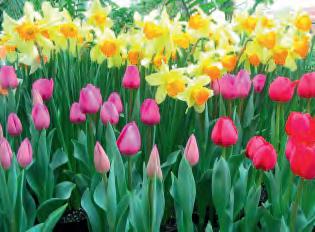














With the recent good weather, spring is on its way. The forests are coming back to life, with bees buzzing again, butterflies flying about, and up in the trees, something wonderful happening.
When spring arrives, one of the most exciting things to see is new leaves appearing on the trees. But have you ever wondered how trees wake up after their winter nap? Well, it’s not as simple as just opening their eyes, because trees were never really sleeping to begin with.
Ellen Whitby, Learning Assistant at Forestry England’s Westonbirt, the National Arboretum, explains it like this: “Even in winter, trees are super-smart and sensitive. They’re always paying attention to what’s happening around them, like how long the nights are, how much water they have, and how warm it is.”
Usually, the first leaves start peeking out from their buds around March or April. But the exact timing can vary because of the weather and other factors. Ellen and her friends at the arboretum keep track of these changes, and they’ve seen buds bursting open as early as February!
Now, here’s where it gets very interesting: the growth of new leaves isn’t random. It’s part of a special plan that trees have. There are tiny things called hormones inside each bud that help the leaves grow. These hormones, such as cytokinin and auxin, are like little helpers that tell the cells to start dividing and growing.
“Springtime at the arboretum is so wonderful! The fresh sights, sounds, and smells make us all so happy after the long winter. “
But did you know that the buds we see this year started growing last year? It’s true!
Dan Luscombe, a tree expert at Forestry England’s Bedgebury, National Pinetum, explains:”Even though we notice the trees waking up in spring, they’re busy all year round. The buds that burst open in spring start forming back in late summer and early autumn. Some trees even have several generations of leaves and buds on the same branch, showing how they’re always growing and changing.” Westonbirt, Tetbury GL8 8QS


Thrive, the gardening for health charity, has launched a new app aimed at getting more people reconnecting with health and nature.
It is the first gardening for health and wellbeing app on the market. It uses gardening and time in nature to improve people’s health based on proven research.
People living with health conditions or those who simply want to use green care to boost their wellbeing, can use the app to garden their way to better health.
It creates a wellbeing plan tailored to their gardening space and time. They don’t need to be an experienced gardener, any space will do whether it’s an indoor windowsill, a balcony or a garden.
It also tracks progress and reflects on their gardening for health journey with a diary and gentle motivation to keep engaged and on track.
www.thrive.org.uk/app
The new season of Rare Plant Fairs continues in April with the longstanding and popular event at The Old Rectory, near Quenington, Gloucestershire, on Sunday, 13th April.
This Grade II listed Old Rectory with its organic garden has been developed over the past 40 years and is in a very tranquil setting on the banks of a mill race, with the River Coln running through the gardens. The wooden bridge that spans the river encapsulates the quirky spirit of fun, creativity and history that comes together at Quenington. There are herbaceous borders, mature trees, pool and bog gardens, as well as the large vegetable garden. The garden also contains a permanent sculpture display. The fair is open from 11am to 4pm and adult entry, which includes the gardens, costs £8. The event supports the work of important local charity Cobalt Health.

There are 21 top-class exhibitors attending. Visit the website for full details.
The Old Rectory, Quenington, Cirencester, Gloucestershire GL7 5BN
www.rareplantfair.co.uk
The leading wildlife charity, Butterfly Conservation, has revealed the dates of this year’s highly anticipated Big Butterfly Count, which will take place from 18th July to 10th August.
The event, which is now in its 16th year, attracts tens of thousands of people out into their gardens, local green spaces or the countryside to spend 15 minutes counting butterflies and helping to track trends and
inform conservation action.
After declining numbers of butterflies resulted in the charity declaring a nationwide Butterfly Emergency last year, it’s more important than ever that people take part this year.
Last summer’s Big Butterfly Count results were alarming. Overall, participants spotted just seven butterflies on average per 15-minute count in 2024, a reduction of almost 50per-cent on 2023’s average of 12, and the lowest in the history of the Big Butterfly Count. It was also the worst summer in the count’s history for several popular species including Small Tortoiseshell and Common Blue.

A welcome to April with joy for the year. The winter has gone, the springtime is here.
PHOEBE HOLDER, AN APRIL SONG





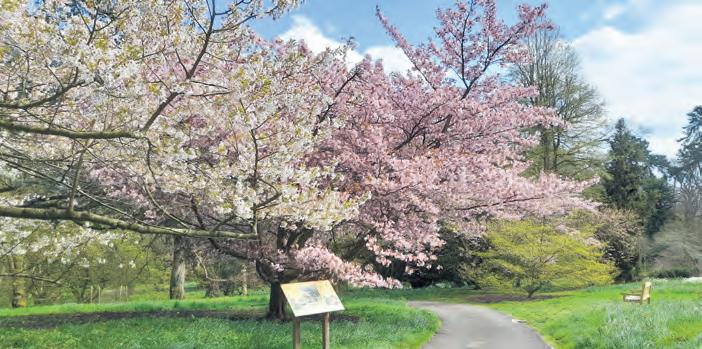
www.batsarb.co.uk
BatsfordArboretum@BatsfordA


SPRING SHOW AT MALVERN

The Alpine Garden Society is holding a new regional spring flower show and plant fair on Saturday, 12th April in the Severn Hall, Three Counties showground, Malvern, WR13 6NN.
The event will open at 10am for plant sales and the flower show itself at 11am until 3.30pm. Admission is £8, and society members go free. There will be 15 specialist plant nurseries and plant society stalls with talks and demonstrations throughout the day. It’s an opportunity to view superbly grown alpine plants. You can purchase many rare and unusual plants not readily available in garden centres from the many specialist nurseries and enjoy the range of things that local producers, garden and other societies have to offer.
www.alpinegardensociety.net
Amberley Gardening Club is holding a plant sale on Saturday, 26th April on the forecourt of Holy Trinity Church/Amberley shop and café from 10am to 12.30pm GL5 5LG.
There will be a wide variety of plants including edibles, ornamentals, annuals, perennials and small shrubs mostly grown by club members. Cash only and there will be hot drinks and cakes and a bric-a-brac stall.

With spring now officially here and when a burst of colour appears in many town and countryside parks, you may feel the urge to pick a flower or two on your way home.
However, as daffodils and other wildflowers begin brightening up the landscape, it’s important to admire them without disturbing their natural habitat, as picking them could cost you a £5,000 fine, warns Julian de Bosdari, chief executive at Somerset plant nursery Ashridge.
According to the Wildlife and Countryside Act 1981, picking, uprooting, or destroying certain wild plants without authorisation is illegal and can result in fines of up to £5,000 per offence.
“With the weather getting warmer, daffodils and other lovely wildflowers, such as bluebells and primroses, are once again coming back into season. It may seem tempting to gather them while spending the day outdoors, especially if you’re on a romantic outing, but doing so can harm the environment and lead to serious legal consequences.
“Respecting wildlife laws not only prevents you from breaking the bank and ruining your month but also helps preserve the beauty of landscapes, ensuring they remain enjoyable for everyone—and for a long time,” added Bosdari.
The garden visiting season is under way and there are beautiful Gloucestershire gardens opening for charity during April, where you can while away an afternoon admiring the plants and helping to raise much needed funds for nursing and caring charities.

KEMBLE HOUSE, Kemble, Cirencester, Gloucestershire GL7 6AD opens for the National Garden Scheme on Thursday 24th April from 2pm until 5pm, a landscaped garden with many tall lime trees and herbaceous borders lining the lawns, the main one in front of the house is a grass tennis court that was laid in the 1880s. A walled garden has many fruit trees and there are two rose gardens, while two paddocks surround the property with Hebridean sheep. Admission £7.50, children free. Visitors can bring picnics to enjoy in the grounds and there’s wheelchair access but with gravel pathways and some steps. Visits by arrangement with the owner are offered between March and May - for more details go to the NGS website (below).
CHARLTON DOWN HOUSE, Charlton Down, Tetbury, Gloucestershire, GL8 8TZ opens for the National Garden Scheme on Sunday 27th April from 11am until 5pm, extensive country house gardens in a180-acre equestrian estate. There are formal terraces, perennial borders, a walled topiary garden, an enclosed cut flower garden and a large glasshouse, the Jubilee copse and rescue animals to enjoy watching. Admission £5, children free, with ample parking, homemade teas available, and wheelchair access. The gardens are also open on other dates in June, July and August, see the NGS website (below) for more details. Find more gardens to visit across the counties Country Gardener covers on page 24

Besides daffodils, flowers such as bluebells, snowdrops, primroses, and wild orchids are also protected under the law, so you should keep your hands off them this spring.
“If you really want to bring spring home, consider planting them in your garden or in indoor vases. You can find and purchase different seeds, bulbs, and even bare-root species in shops—this way, you help preserve the environment for everyone while bringing colour and life to your home,” said Julian de Bosdari.
Badminton House, the historic residence of the Duke and Duchess of Beaufort, is inviting visitors to explore its exquisite gardens during the Open Garden Days held every year in April, June, and September. These events showcase the gardens’ seasonal transformations, from vibrant spring tulips to the lush roses and dahlias of summer.
Guests can meander through diverse garden areas, including the formal east-side beds designed by Russell Page and the South Garden, featuring water squares, hedges, and colourful borders filled with herbaceous perennials like campanulas, penstemons, geraniums, and phlox. A short walk through the park leads to the Walled Garden, home to the estate’s kitchen garden, which supplies fresh produce and cut flowers year-round. An impressive archway adorned with roses, clematis, wisteria, and yellow laburnum adds to the garden’s charm. The greenhouse also offers a delightful display of pelargoniums.
During these events, visitors can enjoy a variety of plant and flower stalls, as well as food and drink vendors. The “A Garden of Botanical Art” exhibition in the Old Hall provides an additional cultural experience, with prints available for purchase.
The opening dates are 27th April, 15th June and 7th September. Gates open at 10 am, with the last entry at 4 pm. Tickets are priced at £10 for adults (£14 on the gate) and £7.50 for seniors aged 60 and over (£11 on the gate). Carers and children under 12 enjoy free admission. Proceeds support the Severn Area Rescue Association and the Church Restoration Fund.
For accessibility, designated parking areas are available near the Church entrance and on the North Front. Most garden areas are wheelchair-friendly, and accessible restrooms are in the Old Hall. Service and medical dogs only are permitted in the private gardens.
Badminton Estate, South Gloucestershire, Badminton GL9 1DD
www.badmintonestate.com
Look out for our May issue of Country Gardener available on Saturday 26th April
Find your nearest stockist www.countrygardener.co.auk/magazine/stockists www.ngs.org.uk

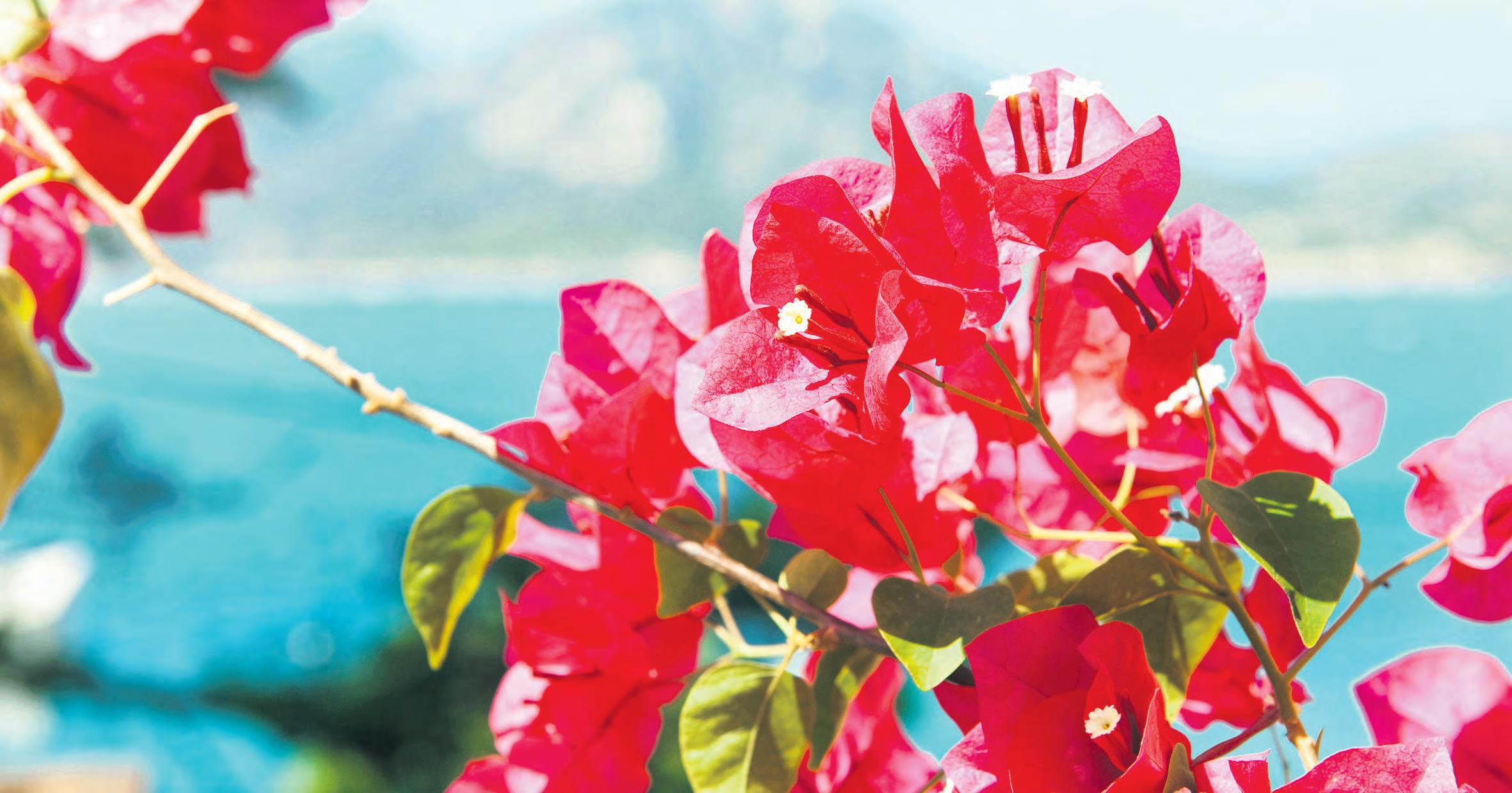
Bougainvilleas are a sensationally colourful plant, which many associate with the warmer climates of the Mediterranean but it is well worth the effort to try and grow them in the UK
In the Mediterranean, the wonderfully colourful bougainvilleas are a doddle to grow, but, here, they are divas that demand some serious tender love and care. But boy are they worth growing!
In the Mediterranean, where they clad villas in falls of vivid cerise purple and fuchsia pink, bougainvillea is pure joy. In the UK, it can be grown on a smaller scale under cover and wheeled out to grace the terrace during the warm summer months.
In its native South America, this liana (climbing shrub) pulls itself up trees and other structures using the thorns on its stems as crampons. The colourful papery ‘flowers’ it is covered in during summer are in fact bracts; the true tiny flowers are nestled amongst the bracts and are often visible as white dots.
At their best, bougainvilleas bulge in masses of these weird and wonderful confetti bracts, like plants made of tissue paper.
In warm climes, the more vigorous vines are capable of scaling ten metres or more and remain evergreen. Whereas, here in the UK, they won’t be as rampant and usually lose some or all their leaves in winter.
There are 17 species, with the most cultivated being Bougainvillea glabra and B. spectabilis, which both hail from Brazil; the hybrid B. x buttiana is also widely grown. All three have fabulously gaudy bracts in shades of neon
magenta, but the 300 or so garden varieties include white, yellow, orange, lilac, red, and two-tone forms. The more compact cultivars can be grown as houseplants, but the bigger bougainvilleas will coat the sunny wall of a conservatory in a curtain of colour. In good conditions, they should perform throughout summer and into autumn, cheering you with paper clouds of electric hot pink.
In a greenhouse or conservatory, bougainvillea can be planted in beds, unless you want to enjoy it outside in summer, in which case a pot is better. The root run is deep, but some containment will enhance flowering, so beds or pots don’t need to be huge. You can add a bit of soil to greenhouse beds, if it isn’t very alkaline (bougainvilleas like slightly acid soil), but compost should make up half the mix or more to prevent waterlogging.
• Under cover: bougainvilleas must be grown under cover for most of the year, unless you have a sheltered garden. Compact varieties can be kept as houseplants. A heated greenhouse or a conservatory is ideal for the large forms; during the warm summer months, they can be placed outside in full sun.
• Moisture: the main mistake people make with bougainvillea is overwatering. It is drought tolerant
As you move your bougainvillea plant outdoors for the sunny spring and summer weather, spare a thought for the young hardworking French woman who discovered this plant for the western world.
Exactly 250 years ago this year, in 1775, Jeanne Baret arrived back in France to become the first woman ever to have travelled around the world… but enroute, high in the hills over Rio de Janeiro in Brazil, she had discovered a truly beautiful plant.
It hadn’t been the easiest journey and the plant was named after the captain of her ship, Captain Bougainville, to stop him from arresting her.
British journalist and author Sally Smith says she has uncovered the full story for her latest book, The Women Who Went Round the World, and says that while credit for the discovery of the bougainvillea has traditionally been given to French botanist Philibert Commerson, it is now without doubt that young Jeanne first found the plant.
and prefers a slightly parched growing medium to excess water.
• Food: feed during the growing season. In early spring, give a balanced liquid feed every fortnight. In late spring, swap it for a high-potash feed. Then, during summer, switch back to the balanced feed.
• Support: provide a climbing structure or frame, such as canes or an obelisk for a small plant and wall wires or strong trellis for larger plants.
• Pruning: tidy big plants with a trim in autumn, if need be, but do the main prune in February or March. Bougainvilleas flower on new wood, so the yearly haircut is important. The pruning routine is not dissimilar to that inflicted upon climbing roses: to begin with, focus on establishing a fan-shaped framework of a few strong stems – cut these back by three-quarters or more and discard the weaker stems. Then, over the next few years, prune your main stems back by two-thirds to three-quarters and trim side shoots to one or two buds.
Remember bougainvilleas are toxic to dogs and cats and the woody stems are thorny, so wear gloves when handling bougainvillea.
• ‘Alexandra’ is a good variety with pink-purple bracts and reaches a decent size. Red-magenta ‘Barbara Karst’ is also excellent and a vigorous grower.
• If you are racy enough to try one of the unusual colours, ‘California Gold’ is rich yellow and ‘Tomato Red’ is scarlet.
• To enjoy bougainvillea as a houseplant, opt for a compact form, such as ‘Helen Johnson’ or ‘Vera Deep Purple’. Bougainvilleas can also be bought and trained as beautiful bonsai.
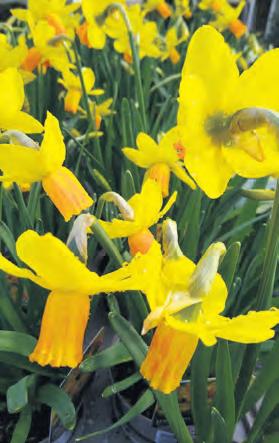



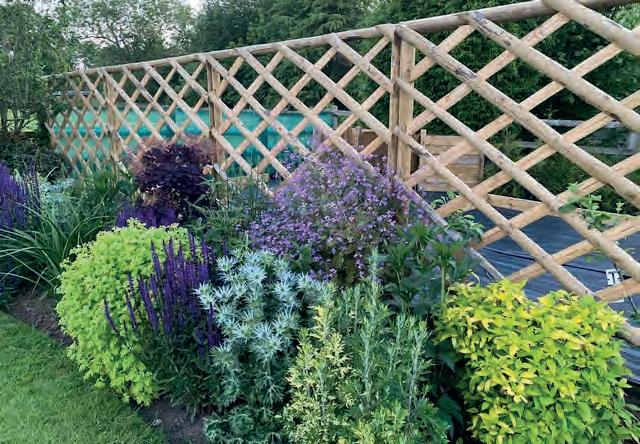


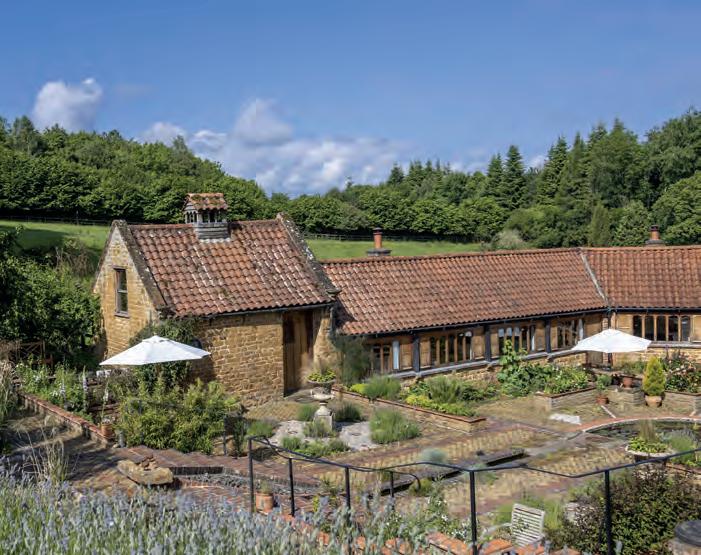
Letting your holiday home has never been easier
At Cotswolds Hideaways our experienced local team is here to make sure the whole process of letting your holiday home is as simple as possible from day one.
Why not get in touch today for a chat or request a copy of our Property Letting Guide?

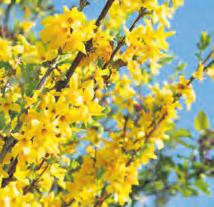








Our native hedges are about to appear in all their glory over the next few weeks offering spring beauty, variety, colour and tradition
It is in early spring when the buds are beginning to form or even open that the traditional native hedges start to take our breath away.
They have a beauty, colour, variety and history which deserves them to be planted by all of us.
If you choose to do exactly that it could be one of the best decisions you’ll ever make, with benefits ranging from year-round beauty to boosting biodiversity.
The choice of these traditional hedges is wide and whether you go to a specialist nursery or to a well-stocked garden centre the choice should be wide and tempting. Here’s a few of our favourites:

A hardy, resilient hedgerow classic and one of the prettiest native trees. In May you’ll get clouds of creamy or pinktinged blossom followed by bright red berries later in the summer. Hawthorn supports hundreds of wildlife species. The fruit is important for birds, especially thrushes into the winter and its dense, thorny growth provides cover for nesting and roosting. Its flowers and leaves are a food source for insects. It’s a prolific producer of flowers and berries, and its dense, thorny growth (hence its alternative name - quickthorn) makes a hawthorn hedge a great choice if you’re looking for security.

Hornbeam hedges form a dense barrier with plenty of year-round interest with their lush foliage, catkins (bearing clusters of tiny flowers) in spring, and winged fruits (known as samaras) that develop later in the summer. It’s a fantastic, extra-tough alternative to a beech hedge in exposed areas.
Hornbeam supports over 170 species of insects, some of which are hornbeam specialists including the caterpillars of some micromoths. Finches, tits and small mammals eat the seeds in autumn and since it can retain its brown leaves through winter, it provides shelter, roosting, nesting and foraging options for birds.

Rowan (mountain ash) is a great choice for a hedge. It is fast-growing, dense, and attractive, and supports a wide range of wildlife.
Rowan’s flowers, fruit, and dense, feather-like foliage provide food and shelter for insects, birds, and mammals. It’s also a hardy plant that can tolerate a variety of conditions, making it a good choice for gardens in both urban and rural areas.
Its five-petaled flowers are creamy-white and grow in clusters in May and June. They turn into crimson-red berries in late summer, and the foliage turns fiery rich in autumn.

This spiny, densely branched shrub is great for hedging. You’ll get a frothy mass of white blossom early in the spring (March) followed by purple-black fruits (sloes) later in the summer.
Blackthorn is a superb tree for wildlife as it provides food for over 100 insect species including black and brown hairstreak butterflies and many moths including lackey, magpie and swallowtail. Because it flowers so early in the year, it’s a good source of nectar for solitary bees and other pollinators. Its fruit is important for birds and small mammals in autumn and winter while the thorny cover provides a habitat for nesting and roosting birds. Take care: while blackthorn is brilliant for biodiversity, its suckering nature may make it less suitable for gardens, more formal spaces or places where you want a neat aesthetic. Weigh up your priorities: do you want a wild haven or sculpted space? Consider your needs and space carefully before choosing this rustic, eco-friendly option.
Beech is a majestic species, perfectly suited to life as a hedgerow. Its glossy green leaves have wavy edges that turn a coppery-bronze and remain on the tree throughout autumn and winter. It’s also fast growing, so a beech hedge is perfect for screening and privacy.
This species is a haven for wildlife. It supports around 100 different insects including caterpillars of the barred hook-


Yew is an evergreen with needle-like leaves and seeds that are enclosed in a red, fleshy berry-like structure. It brings structure and interest all year but especially in winter. It can be clipped and shaped into yew hedges and makes a gorgeous backdrop to flower beds or when layered with other hedges like hornbeam and box.
The fleshy red seed coverings (arils) are eaten by many birds including robins, starlings, fieldfares, blackbirds, and mammals such as squirrels and dormice. Its seed is eaten by greenfinch, bullfinch and hawfinch and its leaves are a food source for some caterpillars. Its dense, evergreen growth provides important cover for roosting birds and invertebrates.
• A hedge looks stunning whatever the season, from the structural beauty of bare winter twigs and clouds of blossom in spring and gold and jewel colours in autumn.
• Privacy and natural screening. Native hedge plants provide cheap and easy screening.
• A traditional mixed hedge is excellent for security. They’ve kept livestock out for centuries so they’ll discourage people too. Hawthorn and blackthorn are fast-growing and make impenetrable barriers.
• During the 20th century an estimated half of all hedgerows were lost from the countryside, yet hedgerows offer a lifeline for wildlife. Bats use them for navigation and they provide food, shelter and nesting places for birds, mammals and invertebrates.
• Hedgerows purify the air around you, producing oxygen and helping capture harmful particulates –especially important in urban areas where levels of atmospheric pollutants are high.








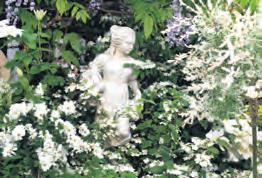
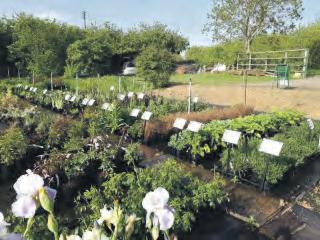






The spring and summer seasons are on the way and with them comes the prospect of stunning sunshine and gardens in rich bloom. Unfortunately, it also brings the hay fever season, which can make it miserable for sufferers if you have the wrong plants in your garden.
The early spring warm weather will send many of us flocking outside to our gardens, but the challenge for allergy sufferers can often be knowing which flowers and plants to stay clear of to avoid high pollen levels. Gardening and plants expert Fiona Jenkin looks at plants to avoid if you want to keep allergies at bay.
The dahlia is a genus of bushy, herbaceous perennial plant native to Mexico and Central America. Their beautiful flowers come in a wide range of colours, from pale pastels to vibrant shades, and they also can be found in different shapes and sizes.
Dahlias are a popular addition for adding colour to borders in the late summer and early autumn and look great in any style of garden. Dwarf varieties can be grown as bedding, while more compact varieties are ideal for growing in pots.
Unfortunately, whilst looking beautiful and attracting pollinators to our gardens, these plants can also cause havoc to hay fever sufferers throughout spring and summer.
As members of the aster family, these flowers pack a lot of pollen, which can easily aggravate allergies.
The common sunflower is a large, annual flowering plant harvested for its edible oily seeds. They are one of the nation’s best-loved flowers, and whilst most varieties have yellow blooms, they can be grown with rusty red, green, and white flowers. Due to their lack of fragrance, sunflowers are often overlooked as a cause of allergies. But those with large heads will produce a great amount of pollen, and the larger the sunflower, the more of a problem it can be for hay fever sufferers.
If you still want to enjoy the stunning sunshine-yellow hue of a sunflower in your spring and summer garden, there are some that may offer a relatively pollen-free option. This is because, in some varieties, the pollen is too heavy to be carried by the wind, which makes it less likely to enter our eyes and noses.
Chrysanthemums are flowering plants native to East Asia and Northeastern Europe, with the centre of diversity lying in China. They are probably most familiar to us as cut flowers but also make for eye-catching and versatile garden plants.
These flowers add colour to borders and containers in late summer and autumn and come in various shapes, sizes and colours.
Another member of the aster family, chrysanthemums, comes with strong allergyinducing pollen, which is airborne and plentiful due to the number of flower heads in a plant. Hay fever sufferers may find themselves sensitive to certain parts of the plant, including its pollen, leaves, flowers, and even the stem.
Fortunately, there is a selection of beautiful replacement options that won’t cause the same problems for those with allergies. Roses and peonies are great alternative options, as rose pollen is too large to become airborne, and peonies are pollinated by insects rather than the wind.
This is one of the most common grass species in the UK due to its durability, easy germination, and ability to thrive in cold and wet climates. The growing habit of perennial ryegrass makes it ideal for lawns, as it is clump-forming and responds well to regular mowing.
As well as being a popular lawn grass, ryegrass is widely grown as a forage crop for livestock, and many different forms have been developed. When left to grow, this type of grass can be identified by its green, narrow, and blade-like stems.
Unfortunately, ryegrass can cause big problems for hay fever sufferers because it is pollinated by wind. This means that the pollen is loosened by the wind and becomes airborne triggers allergies.
Grass pollen is the most irritating type of pollen for hay fever sufferers and affects an estimated 90% of people with the allergy. Ryegrass is a regular feature of British lawns, so it can be difficult to remove if it is already present.
Also, in the aster family, ragweed is not technically considered to be a garden flower, though it is sometimes planted by gardeners who appreciate its ability to feed bees. It is, however, a common invasive weed in UK gardens, so even if you have not planted it, it is something you may need to keep on top of.
Ragweed is heavy with pollen and is known for causing irritation to the eyes, nose, and throat. It can even worsen asthma symptoms. Just a single plant can produce up to one billion pollen grains. The pollen is very lightweight and, therefore, easily moved around in the breeze – so if you are a hay fever sufferer, quick removal from your garden is essential!
Growing your own vegetables and fruit can be very cheap, or even free, and therefore the crop is almost pure profit but it is vital to plan what you grow
When cash is tight, growing your own fruit and vegetable is an empowering and rewarding way to stretch precious budgets that little bit further. But what are the highest value crops you can grow to save the most money?
Growing the right things at the right time is key to budget conscious gardening even on the smallest of scales.
Some crops, such as maincrop potatoes and onions are cheap to buy in shops most of the time, so growing your own will not save you a lot of money but runner beans, cherry tomatoes, courgette plants and leeks are extremely productive, so you’ll harvest generous amounts from a smallish space.
Salad leaf seeds are another good investment, as they grow fast and give useful crops from the tiniest patch, or a container.
Early and late crops are another good bet, as they crop when fresh veg and salads are at their priciest in the shops. ‘Exotic’ or unusual crops, such as mangetout peas, celeriac, golden courgettes or yellow tomatoes are expensive to buy, but easy to grow from seed. Although crops such as peppers, chillies and aubergines do best in a greenhouse, they’ll grow well in tubs on a sunny, sheltered patio.
Here’s Country Gardener’s top money saving option to grow.
This is by no means a definitive list. It goes without saying you should concentrate on those fruits and vegetables you enjoy eating most but get smart and start swapping expensive buys with delicious garden-grown replacements. Look for plants that make the most of space, that crop prolifically or that have a superior taste you’d struggle to find in the supermarket without paying over the odds.
Leeks are easy to grow from seed and a £4 packet of seeds will produce a sensational harvest in the autumn and winter. Leeks are notoriously expensive in the shops for most of the year, so they rank very highly on the cost savings stakes. They can also stay in the ground through frosts and can be picked when needed.
Leafy greens such as chard and kale can give a steady supply of leaves for many months, making them very hard-working vegetables. While we’re always being told to ‘eat our greens’, sourcing field-fresh greens, without the wilt, isn’t easy. But with homegrown greens you’ll always be sure of fresh leaves to enjoy steamed, stewed or blitzed up into your morning smoothie.

Packets of leafy herbs cost a small fortune in the shops because they are hard to store and don’t travel well. But gardeners don’t have to worry about any of that and can grow the likes of basil, parsley and coriander to harvest fresh, as needed. Leafy herbs take up very little room and grow profusely.
Whereas onions are cheap to buy and take up quite a lot of space, garlic is relatively costly yet efficient on space. Softneck varieties of garlic store well too, making this crop ideal for spacing out the usefulness of a single harvest. Garlic is done by midsummer, leaving plenty of time to grow a follow-on crop that will bring further homegrown value to the dinner plate later on in the season.
Soft fruits such as strawberries, raspberries and blueberries require careful handling and packaging to keep them blemish-free, which makes them often pricey. But grow these fuss-free fruits yourself and you can save the pennies while enjoying some of the tastiest fruits you’ll ever experience.
Courgettes are infamous for heavy cropping. The courgette’s versatility in the kitchen – used in everything from stir-fries to cakes – makes this one vegetable worth making room for.
Celery’s an important base ingredient to many soups, stews and salads. It makes this list thanks to its compact shape and the fact you can harvest it one stem at a time, meaning none of the waste associated with purchasing whole heads of celery. Selfblanching varieties are the easiest to grow.
Quick-growing salad toppers such as radishes, baby beets and spring onions offer prized pickings for the cost-conscious gardener, reaching harvest point in as little as four weeks. Make repeat sowings as you harvest, throughout the growing season, and a small patch of soil can yield a surprising weight of fresh produce. You can even grow them in gaps between slower maturing crops.

Save your own seed
Collect traditional non-F1 hybrid varieties, but only when they’re grown at least 250 yards away from other varieties of the same veg which might cross-pollinate them. Don’t save F1 hybrids.
Save part-used packets of seed
Roll down the tops of the packets each time you use some, and store any left over at the end of the season. Don’t bother saving parsnip seed – they need to be bought fresh each season.
Sow seeds thinly and evenly
Sow sparingly to make a packet of seeds go further. It also saves a lot of thinning out for direct-sown seeds, and means easier pricking-out when you sow in pots. Mix small seeds such as carrots with sand if it helps to sprinkle them thinly.
Share seeds with friends or neighbours
Give away or swap surplus veg seedlings among yourselves. This is ideal when each of you wants just a few plants of several varieties. Suggest the gardening club sets up a table so members can sell their spare plants.
This can be the cruelest month with sunshine but frosty mornings and nights so keep an eye on the weather
April is often described as the most beautiful month of the year with bulbs, shrubs and alpines all bursting into bloom. These plants bring fantastic colour and scent to the garden. There is a variable weather pattern of sunshine and showers in April which is great for the flowers.
It is also a busy month but as the days length is longer, then there is plenty of time to enjoy your garden. It is one of the busiest times in the garden, but don’t panic,
Sweet peas should be something of a priority and now is your last chance. Sow into deep pots or root trainers as they dislike any sort of disturbance. Or, you can look out for young plants in nurseries and garden centres. Check whether they are grown for scent or for cutting. Some longer stemmed varieties may smell less strongly.
Also sow marigolds, petunias, nasturtiums, asters, zinnia and salvia indoors or in the greenhouse.
Outdoors you can sow native wildflowers and hardy annuals such as poppies and sunflowers.
3
take things one step at a time and you’ll get it all done. It’s important to take a few moments to sit in the sun, listen to the birds and plan your gardening.
April, as they also say, is the cruellest month with sun one minute and frosty mornings and bitter winds the next. In the garden tender young leaves are prone to frost burn and judging what to do when is tricky. It’s all a question of timing.
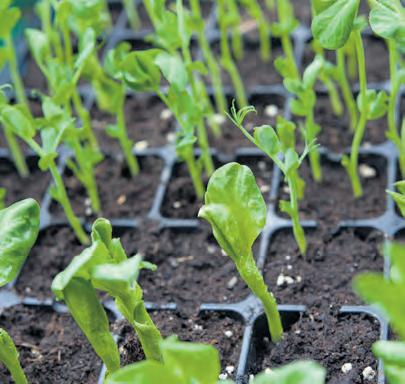

It’s
April should see the soil warming up and should now be warm enough for seeds to germinate so, once the nights begin to warm up find room for carrots, parsnips and beetroot. Start sowing spinach and chard. These can go direct into the soil and will need to be watered well until they get going. Avoid letting them dry out or they might bolt.
Sow broccoli, kale and Brussels sprouts for winter. Sow individual seeds into modules and leave to germinate either in the green house or a windowsill. They should appear within a couple of weeks. Once they have reached about four inches they can be hardened off and then planted outside.
Sow runner and French beans two to a small pot indoors or under glass. Keep the soil moist and they should soon germinate.
Potatoes need to be planted this month. New potatoes go in early to mid April. Maincrops follow in the second half of the month but exactly when you plant your potatoes will depend on local conditions. The key is to avoid emerging foliage being burned by frost. New potatoes (also known as First and Second Earlies) should be spaced a foot apart.
• Keep azaleas and rhododendrons looking good by pinching off fading flower heads above a new set of leaves.
• Deadhead early flowering primulas as early as possible, as they tend to cross-breed very easily.
• Early April is your last opportunity to hard-prune late-flowering shrubs.
• Stake your perennials before it’s too late. Create attractive willow or hazel structures.
• Remove pure green branches from variegated shrubs, such as elaegnus, privet and euonymus –cut them right back to the main stem with secateurs.
• Start spraying roses using an organic-approved garlic formula; the key is to start early and spray often.
You can sow tomato seeds through to the end of April. Keep young plants protected from the cold. Tomatoes grow quite quickly, so will need potting-on several times. Once the last frost has passed (hopefully by now) you can plant them out. Once the first flowers form, feed with liquid tomato food which is packed with the essential nutrients your tomatoes need to thrive!
For beautiful displays in the summer, plant hanging baskets now and grow them in a greenhouse. Fill your baskets with compost and add slow feed granules , to give your plants the best start, with six months’ worth of feed, for stronger roots and greener foliage. To reduce summer watering, add a deep plastic saucer to the bottom of the basket, to act as a reservoir.
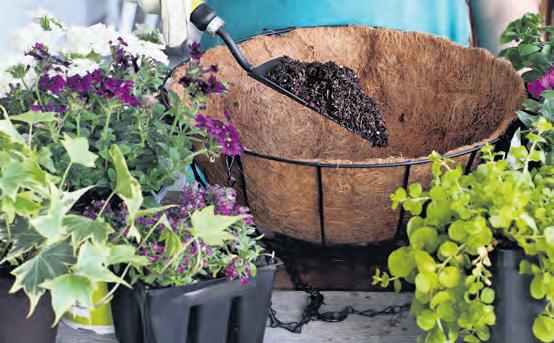
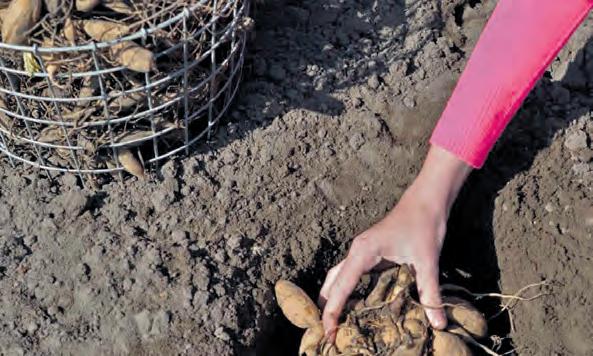
4
2 5 6
Bringing dahlias in for the winter doesn’t just protect them against frost. It also allows them to dry out properly, and helps you bring them on a bit earlier. They’re now ready to be planted so it’s time to look ahead to get things right for later in the season.
Give tubers a sprinkling of water in early spring, and they’ll start to produce young shoots in April.
Dig a planting hole, making sure it isn’t too deep. The shoots are still delicate, and you don’t want to damage them.
Gently pour coarse sand over the tubers; this prevents them from rotting and it’s also a great slug repellent.
Backfill with soil and add a ring of sand to mark the planting spot.
Climbing plants head skywards as temperatures rise. Some, such as passion flowers, are masters of clinging on, using tendrils to firmly attach to supports. Others such as climbing roses and honeysuckle may need a little bit of help, especially if conditions are windy. Use garden twine or string to anchor new growth to supports. Installing trellis can help, too. Obelisks offer shelter and support for climbers while looking ornamental in borders.
In an ideal world one would only grow a handful of plants that need support, but in small gardens and where plants are drawn up to reach for light, this will be necessary. Hazel twigs are excellent, but steel hoops are most easily installed. Make wigwams for sweet peas and climbing beans. It is early in the season but fruit needs attention.
To avoid risk of infection, stone fruits such as plum, cherry, peach, nectarine and apricot should only be pruned during the growing season. Prune late April, when the plants are in leaf and after flowering. Immediately seal all cuts greater than one centimetre with wound seal.
Repot your citrus in fresh citrus-specific compost. If you can’t find this, ericaceous is the next best thing.
Top dress blueberries grown in pots with ericaceous compost. It’s important to have two different varieties of blueberries to get good production – they will fruit without, but you’ll get a paltry quantity.
‘Fingers crossed we’ve made it through another winter!’
Jack Stephenson retired two years ago and spends more time gardening and now appreciates the changes in the seasons and especially the joy of welcoming spring
It is tempting to get sowing and growing but there is one important task still this early in the season.
It’s one of the oldest clichés in gardening: the answer lies in the soil. And as all good gardeners know, it’s true! Improving soil now will pay dividends come summer, resulting in bigger crops and more flowers. Buy sacks of well-rotted manure and dig or fork it into border soil and vegetable patches (don’t let manure meet stems of shrubs and plants). If you don’t have access to manure, the contents of your compost bin can work wonders. Open the access hatch at the bottom and if the material inside is brown and crumbly, it’s a nutrient-rich wonder that’s ready to be dug into soil.

If you have a greenhouse, sweet peppers are a must. They’re one of the easiest crops to grow and have a multitude of uses in the kitchen – adding flavour and crunch to stir fries, summer salads and fajitas. Red, green and yellow varieties are commonly available. Seeds should be sown as soon as possible this month, placing seed trays or pots in a propagator at around 20°C. Once the first pair of leaves have formed, seedlings should be prickedout into pots. Sweet peppers thrive under glass.
All soft fruits, for example strawberries, raspberries, redcurrants, blackcurrants, and gooseberries, will benefit from a mulch. Garden compost, leaf mould, organic manure, straw, hay and spent mushroom compost can all be used. 10 8 9
As light levels increase and temperatures rise, houseplants put on new growth. Increase watering and start liquid feeding – general purpose feeds such as Baby Bio cater for a broad spectrum of houseplants, while specific feeds are available for orchids and citrus. If a houseplant looks unhappy and has been in its pot for two or more years, it may need to be re-potted (roots bursting from drainage holes at the bottom of the pot are a tell-tale sign). Choose a slightly larger pot and fill with houseplant or loam-based compost. Never use houseplant compost for orchids though, which need an open, bark-based orchid compost that allows air to reach the roots.

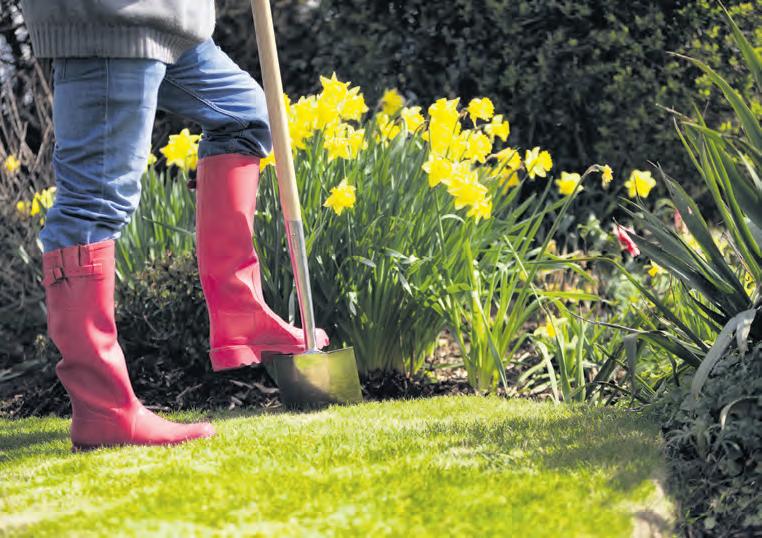
“What about the joy of coming out of winter and into spring?”
Every early spring there is a day or two which changes everything.
The sun comes out with real some real warmth and in an instance, it is possible to properly look ahead and forget the dark bleak days of winter.
Of course, there will still be cold, wet days to come-often right through to April and beyond -but that first day or two of sunshine and warmth means so much to gardeners like myself.
It’s a sign to get ready.
There is something about getting the sun on your back and warmth on to your shoulders that makes me impatient and keen to get myself clearing up, sowing, digging , raking and potting.
It is of course about being reminded what a warm spring day feels like. But getting into March we all think perhaps that there’s hopefully not much more winter is ready to throw at us with any long, cold spells.
Fingers crossed we’ve made it through another winter.
Two years ago I finally decided to retire from my small but successful estate agents’ business in north Devon. It took a while but I was able to sell it. I had always planned to spend more time on my long-term passion -gardening on our almost two-acre plot by the coast.
Hard work in a business and gardening doesn’t always go together and most gardening seasons I was always behind, slow to get things done early and never able to catch up. It was frustrating and something I always felt sad about.
Being out of doors in all weathers has always appealed to both myself and my wife whether its walking or pottering about in the garden on cold dry days.
Which brings me to finally the main point of me writing to your excellent magazine.
It is to me all about appreciating the changing seasons in England, how different they are, what each has to offer, how we need to find things to love and appreciate and what each one really means to someone who gardens a lot. After two years in retirement, I am so much more aware of it.
I have family who now live in Cyprus and who moved there a few years ago now. They have become successful expats, soaking up the sunshine and the outdoor way of life. We are always being offered the chance to join them.
‘There’s over 320 days of sunshine here’ is the regular claim as if that was all that mattered in life!
Then there are friends living in the sunshine state of California who seem proud of great weather. England, they say is cold and wet.
But what about the seasons and what each one offers? What about the joy of coming out of winter and into spring, the beauty of summer, my favourite season the autumn and yes it can be tough but we can all find something to love and hate about the winter. It can be a trial and it can be long but it makes spring all the more special. I have no desire to live where the garden and the countryside and the weather doesn’t change dramatically.
The changing seasons have become a poetic journey for me in retirement. As spring approaches, I look forward to seeing how Devon goes into another transformation, taking off its winter coat and blossoming into a display of colours.

We can finally be confident that April spells an end to winter and the beginning of a new gardening season packed with exciting visits, days out and things to do.
There are often some false starts to the end of spring but now we are ready to enjoy April, the end of winter and the start of what is the proper gardening season is with us.
We can all see our own gardens start to come to life and that’s the signal for a whole range of gardening events to enjoy from spectacular west country garden spring displays to plant fairs , shows and many gardens to visit, Many private gardens have new season offerings with tulips displays at some venues a particular favourite. Magnolias and displays of spring blossom are also on the list of much-loved displays
It’s been a long wait so we are delighted to offer you some ideas of ways to get yourself back into the swing of gardening themed visits with some great days out.
Hardy Plant Society Somerset Group’s Annual Plant Sale will take place at Monkton Heathfield Village Hall, Monkton Heathfield, Taunton TA2 8NE on Saturday 26th, April from 10am to 12.30pm. The village hall is half a mile from Monkton Elm Garden Centre. Admission is £1 on the door, there is free parking on site and refreshments for sale. There will be a large selection of quality hardy plants (many perennials) grown by our members at reasonable prices, including some unusual varieties. There will also be some specialist nursery stalls present, so a great opportunity to find some interesting plants.
The Royal Bath & West Show is introducing an App for the threeday event held between May 29th and 31st to enhance visitors’ show experience. With full timetable information and a feature to create your own line up of favourite attractions, the App will make sure you don’t miss those demonstrations and exhibits you really want to see! It will be released in April, so keep visiting the Bath & West Show website and social media channels to be amongst the first to download it.
Advanced rate tickets are available until 28th May, for prices and to book yours visit www.bathandwest.com
The Bishop’s Palace Garden and Country Fair kicks off ‘ a series of big summer events for this year at The Bishop’s Palace in Wells.
Set within the breathtaking 14-acre RHS partner gardens, the fair is a celebration of all things garden and country. Whether you’re a passionate gardener, a nature enthusiast, or simply looking for a fantastic family day out, the fair offers something for everyone.
Adult tickets are £16 with children £8.
Another of the early summer events takes place on 14th and 5th June with History Live! where you can step back in time and experience history brought to life at History Live 2025, a weekend filled with demonstrations, captivating displays, and unforgettable experiences.
Set within the stunning surroundings of The Bishop’s Palace, this event is perfect for history lovers.
The Bishops Palace, Wells BA5 2PD
Packed with inspiration and ideas for the popular Forde Abbey will be a plant and gardening fair on Saturday 5th April. There will be some fantastic specialist nurseries from the southwest selling plants and excellent craftsmen with brilliant and beautiful gardening sundries from 10.30am to 3pm.
The growers are happy to chat about their plants and offer their expertise and share their enthusiasm, so do come along to see what you can add to your own garden for a splash of colour this spring – or just admire the beautiful plants on show!
The fair takes place at the beginning of the popular tulip display, a lovely time to see the garden waking up from its winter hibernation.
The in-house plant nursery is also open from 10.30am to 5.pm and it is fully stocked with spring bulbs and a diverse range of herbaceous perennials, many rare and unusual. The gardens will remain open until 5pm (last entry at 3pm).
A reduced entry fee of £5 to the Plant & Gardening Fair, including admission to Forde Abbey’s 30-acre gardens. Parking is free as is entry to Forde Abbey and Historic House Members.
Forde Abbey Estate, Chard TA20 4LU


A real hidden gem – we’ll be back!’ ‘What a glorious, tranquil place – divine plants’ ‘Yummy cakes!’ Planted by a tumbling stream in a peaceful Dartmoor valley just north of Ivybridge, Lukesland Gardens’ fine collection of camellias, magnolias, and rhododendrons will be a blaze of colour for Easter this year. Just five minutes’ drive from the A38 you will find yourself suddenly transported into another world of exotic plants and wonderful bird song. With its popular tea room, serving home-made soup and cakes, an exhibition of prints by local artist Louise Scammel, and a fun children’s trail, these 24-acre gardens have something for everyone. Parking is free and your dogs are welcome on a lead. Lukesland Gardens are open 11am to 5pm on Sundays, Wednesdays and Bank Holiday afternoons (including Good Friday) until 12th June.
For more details go to www.lukesland.co.uk or phone 07906480362
Lukesland House, Ivybridge PL21 0JF
This is an RHS partner garden with a Grade 1 listed medieval priory backdrop. A mix of classic and modern features, including a ‘hot’ border, sub-tropical walk, blue garden, Mediterranean garden, shade border, Southern hemisphere and a winter garden. Home to Somerset’s only botanical glasshouse, featuring hundreds of different species from around the world such as the magnificent jade vine (Strongylodon macrobotrys). There’s also a gift shop, tearoom, and specialist plant nursery; plants are propagated on-site and sold at great prices! Open Tuesday to Sunday, 10am to 3pm/4pm/5pm (seasonal), year-round excluding two weeks at Christmas. Last admission to the gardens is one hour before closure.
The Walled Gardens holds a variety of events and special offers throughout the year suitable for all age groups. Please check out the website for further information.
Church Street, Cannington TA5 2HA Tel: 01278 655042
Email: walledgardens@btc.ac.uk
One of the most popular plant sales in the Cotswolds returns on Saturday, 26th and Sunday, 27th April when West Kington Nurseries hold their massive plant sale. Entry over the two-day event is free and visitors will have the chance to wander over the five-acre site of the nursery which promises to be bursting with plants. Catalogues for the sale are sold in aid of local charities.
Call 01249 782822 or visit www.wknurseries.co.uk for more information. West Kington Nurseries, West Kington, Chippenham SN14 7JQ


24 acres of Rare Shrubs, Trees, Pools & Waterfalls Home-made soups & cakes
Sunday 16th March to Sunday 8th June, Suns, Weds, Bank Holidays 11am - 5pm

Tea Room & Walled Garden Nursery


Nestled in the heart of North Devon, Marwood Hill Garden is a hidden gem
Home to four National Plant Heritage collections, this private valley garden spans over 20-acres and showcases three stunning lakes, rare trees & shrubs, and colourful surprises throughout each season. Not only a haven for wildlife, the garden is also the perfect environment to explore and be inspired. Enjoy a day of inspirational and relaxation for the whole family.
Catch up over coffee and homemade cake or a cream tea in the picturesque Garden Tea Room or take a bit of Marwood magic home with you from our Walled Garden Nursery and Plant Sales.

Enquiries & Tea Room 01271 342528

Plant Sales & Nursery 01271 342577 e info@marwoodhillgarden.co.uk w marwoodhillgarden.co.uk
Marwood Hill Gardens, Marwood, Barnstaple, Devon EX31 4EA


Discover a subtropical paradise, tucked into the cliffs above Salcombe. Explore the gardens and surrounding coastal walks, farmland and woods. Dogs on short leads are welcome.
Sharpitor, Salcombe, Devon, TQ8 8LW nationaltrust.org.uk/overbecks-garden



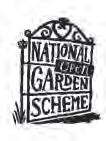



Bluebell Sunday 13th April and Easter Fun 20th & 21st April
Film location for Enid Blyton’s ‘Malory Towers’ & ‘The Salt Path’ Visit this stunning family home in the Easter holidays with its fascinating collections, exhibitions, walled and woodland gardens and wildflower walks to the beach.

* Dogs welcome * Holiday Cottages * * Delicious light lunches & cream teas * House, Gardens etc open until 2nd October Sunday to Thursday plus Good Friday 11am - 5pm (House 2pm - 5pm last adm 3.45pm) For more information and special events see www.hartlandabbey.com Hartland, Nr. Bideford EX39 6DT 01237441496/234
As spring arrives, Westonbirt, The National Arboretum comes alive with vibrant new life. The warmer spring days bring the emergence of many forms of new life, from tree buds bursting into flower to the sound of songbirds and sights of newborn wildlife.
Why not discover more about this living masterpiece and what Westonbirt’s team are doing to encourage 100’s of species to thrive? Join one of Westonbirt’s guided spring walks or family-friendly events and immerse yourself in the beauty of this biodiverse haven.
Plan your visit at Forestryengland.uk/westonbirt/spring-westonbirt-arboretum
April heralds the arrival of the extensive collection of magnolias and camellias which will be flowering in the gardens. Early April sees the deep pinkish-purple flowers of magnificent Magnolia ‘Marwood Spring’ bursting open just below the tea-room; it can’t be missed! and is part of the Marwood Heritage Collection. Well over eighty camellia plants are in a big greenhouse in the walled garden and are a riot of colour at this time of year. Elsewhere in the garden large camellia plants are in full blossom and an area at the top of the garden has been planted over the last 16 years where an avenue of nearly 100 forms creates an avenue of contrasting colour. Did you know Marwood is an International Camellia Society Garden of Excellence too?!
The scree garden just below the walled garden looks wonderful this month with masses of dwarf specie tulips forming a carpet of glowing colour. All around the garden daffodils are naturalised in the grass below the spring display of glistening white cherry blossom.
Lastly Marwood’s tearoom is a great stop for something to eat and refresh on your walk around and the final stop must be plant sales, where there are some really unusual plants for sale.
Marwood Hill Gardens, Nr Guineaford, Barnstaple, North Devon EX31 4EA Tel: 01271 342 528 Email: info@marwoodhillgarden.co.uk www.marwoodhillgarden.co.uk
The picturesque gardens at Little Malvern Court sit below the wooded slopes of the Malvern Hills, with far-reaching views across the Severn Valley to the Bredon Hill and the Cotswolds. Features to look out for in May include the beautiful pots of tulips, grouped according to colour, surrounding the house. The varied flowering cherries and crab apple trees will be in blossom. Wildflowers begin to appear in the grass banks and lovely blue camassias pop up in the tall grass of the meadow. In the rose garden, alliums literally burst into flower and the early roses start to open.
There are cedar trees, planted from seeds brought back from the Holy Land by Charles Michael Berington. The chain of lakes, formerly fish ponds for the monks, follow the layout from a plan dated 1720 and, like much of the garden, were restored in the 1980’s.
Little Malvern Court & Gardens Little Malvern WR14 4JN Tel: 07856 035599 www.littlemalverncourt.co.uk


The season of Rare Plant Fairs continues in April with the long-standing event at The Old Rectory at Quenington, near Cirencester, on Sunday, April 13th, from 11amto pm, in support of Cobalt Health.
A great selection of specialist nurseries will be attending the Fair, all of whom are experts in the plants that they grow. There will be a wide range of interesting and unusual plants for sale, including choice on a great selection of unusual shrubs, all accompanied by the expert advice that you need to select and grow the right plants for your garden.
There are 13 fairs this year. Visit the website at www.rareplantfair.co.uk for full details of all the events, including lists of the exhibitors attending.



















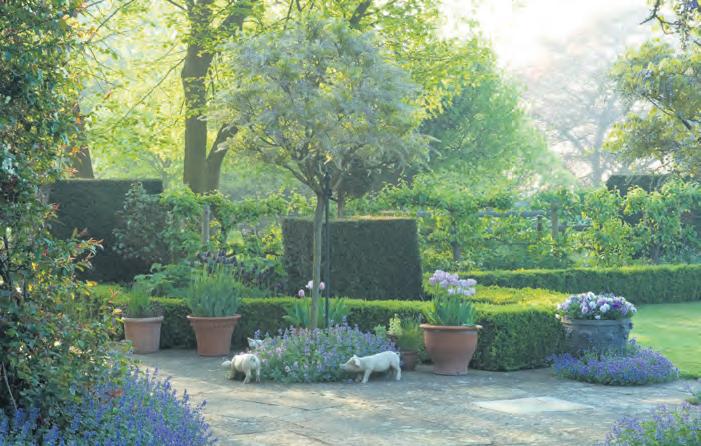



















April is a wonderful month for visiting Hartland Abbey with wild garlic, bluebells and primroses everywhere and the emergence of azaleas and rhododendrons in the woodland walks, tulips and narcissi in the Walled Gardens. This year Easter falls at prime bluebell time, carpeting the walks from the Walled Gardens to the sea at Blackpool Mill. Bluebell Sunday on 13th April is a lovely time to visit at a reduced entry rate. Easter bunny hunts on Easter Sunday and Monday are great fun for families who will also be able to search out their favourite ‘Malory Towers’ locations!

If you’re a lover of all things bright and beautiful then there’s no better place to look than the gardens opening with the National Garden Scheme full of daffodils for those wonderful golden moments this spring. There are a host of lovely gardens opening over the long Easter weekend too, a wonderful time to get together with family and friends and to explore the great outdoors – and children go free in most gardens. What could be better than an affordable day out in a beautiful garden –and perhaps a slice of delicious home-made cake!
Find a garden open near you: ngs.org.uk
Hartland abbey, Stoke, Bideford EX39 6DT
gardens
Kelmscott Manor was the iconic country home of William Morris; father of the Arts and Crafts movement.
Today, visitors will find an outstanding collection which spans over 300 years and reflects the lives, ideas, and creative legacy of those who lived and stayed there.
The domestic charm and ambience of the house is still retained and having influenced Pre-Raphaelite art and design and the Arts & Crafts Movement, its legacy still very much treasured today.
Kelmscott Manor also boasts enchanting riverside gardens and the River Thames is located just a few hundred yards away.
For more information visit kelmscottmanor.org.uk Tel: 01367 252486 Kelmscott Manor, Kelmscott, Lechlade GL7 3HJ

Be part of the world’s leading cultivated plant conservation charitySomething for everyone interested in plants and their conservation:
• talks and celebrity lectures, plant fairs, garden visits,
• plant exchanges, propagation & social events.
& IoW
Mon 5th May 2025 10am - 4pm at Longstock
Join online at www.plantheritage.com, or at our May Plant Fair and we will refund your admission.
This spring, why not make it a priority to visit National Trust Overbeck’s Garden, terraced into the cliffs above Salcombe, South Devon. Escape into a world of vibrant blooms and exotic subtropical plants set against stunning views of the Salcombe estuary.
Meander tranquil pathways, framed by tall palms, with glimpses of the sea at every turn. This unique coastal setting is the perfect backdrop for a leisurely exploration. For those seeking a more active adventure, the South West Coast Path beckons, with scenic walks directly from Overbeck’s to Bolt Head and beyond.
Don’t miss the opportunity to join a guided garden tour on Wednesdays at 2pm (pre-booking essential), where you’ll delve into the secrets of Overbeck’s rare plant collection. For 2025 season, dogs are welcome on short leads and with parking available and refreshments to enjoy, Overbeck’s Garden promises an unforgettable springtime retreat. Open Sundays to Thursdays 10.30am – 4.30pm. TQ8 8LW



Mary Clarke shares what she admits is a totally out of control love of dahlias in their many forms which have captivated her since she was a student



Why do I love dahlias?
They are a little doolally aren’t they?
Blowsy, often very big and brash, crazy colours, and sometimes odd-looking flowers. The foliage is lush and loved by slugs, yet they drive dahlia lovers like me wild with desire at times.
Near me in Dorset we see in autumn whole front gardens full of dahlias, crazy mixtures of colours and shapes. There are getting on for 18,000 RHS registered varieties of all shapes and designs. I don’t love them all and some I actively dislike but there are plenty left for me to love.
I studied horticulture at Shuttleworth College in Bedfordshire and had a solid grounding in growing and the plant world and one thing stood out were dahlias and that’s where the love affair started.
It wasn’t for any single reason. I found the story of dahlias romantic and spellbinding.
I loved the different varieties.
I loved the fact that they were at their best in the autumn my favourite time of year.
I’ve been growing them ever since. My garden is full of them. I grow them in cut flower beds and a decorate the house with them.
I guess I grow all sorts that doesn’t make it boring.
I must also admit to loving the history of the dahlia which is tied up in romance, travel and adventure. So, here’s my history lesson.
Little is known about the dahlia before the time of the Aztecs. It is believed that they used parts of the dahlia for food and medicine. The root was bitter- a cross between a radish and chicory.
Today, this flower remains the National Flower of Mexico where its great beauty was first discovered by these mighty Aztec Indians.
They grew hundreds of varieties of dahlias and used them for medicinal purposes.
The next time dahlias appear in history is 1789, when the director of the Botanical Garden at Mexico City sent plant parts to Antonio Jose Cavarilles, who worked at the Royal Gardens of Madrid in Spain. From these he grew three new plant forms, Dahlia pinnata D rosea, and D coccinea. He named the genus after Andreas Dahl, a Swedish botanist.
Seed and plant parts from these dahlias were sent throughout Europe beginning in the early 1800s and the first fully double forms began to make their appearance, as did many new colour combinations.
It was during this time that the scarlet Dahlia coccinea was crossed with a mauve-flowered species, possibly D pinnata, which ultimately resulted in the first modern dahlia hybrid. This was easy to grow and hybridise so they quickly became very popular in European and American gardens.
Through the 1800s and 1900s, thousands of new forms were developed, with 14,000 cultivars recognised by 1936,
and in the past century nearly 50,000 named varieties have been listed. All these dahlia forms were hybridized from at least two, and possibly all three, of the original dahlia species from Mexico.
After 200 years of culture, selective breeding, and hybridizing, today’s dahlia has one of the largest variations of forms, colours, and sizes of any flower grown. More dahlia hybridizers are active now than at any other time in history, which means a constant addition of varieties each year.
The story of how Empress Josephine became the champion of the dahlia flower in Europe is an interesting one. According to Andrew Smith, as the 18th century came to an end, the Spanish were entrenched in Mexico and they had a monopoly on a particular dye that was uniquely found in Mexico in the Mexican carmine grana insect. The female dried insects were used to make an intense red dye known as cochineal.
At this time, French tapestry and fabrics were well known for their craftsmanship all over Europe, and the French needed this intense red dye to enhance their fabric.
As the French got tired of relying on the Spanish to supply them with this red dye, the French Minister to Mexico decided to smuggle a few of the carmine grana insects to France. Along with this shipment of insects inadvertently came a large batch of dahlia tubers. When this shipment arrived in France, the insects had died but the dahlia tubers survived.
But the French Minister turned this disaster into an opportunity. He offered the dahlia tubers to Empress Josephine, Napoleon Bonaparte’s Queen at the time. Empress Josephine was an avid gardener. She had a life long love of flowers from a young age and grew an extensive array of plants and flowers. Under her expertise, the dahlia tubers thrived and bloomed prolifically, and soon became the envy of everyone. But she guarded these dahlia plants and wanted them to be exclusively hers. Eventually a Polish count who was visiting her home bribed a lady in waiting and one of the gardeners to dig up over 100 dahlia plants and took them back with him to propagate. Empress Josephine was so angry at this thievery and at the loss of dahlias and her exclusivity that she ordered all the remainder of the dahlia tubers to be dug up and ground into mulch.
Soon after her death at the age of 51, Josephine’s dahlias became more common and a popular plant in Germany. By 1826, over 60 varieties were recorded.
It is the British however who embraced the dahlia and took it to the next level of popularity. Dahlias worked perfectly within the flamboyant Victorian style of gardening and gardeners started using them extensively in English landscapes. The dahlia became the flower of the nation – at least by numbers. They have dipped in and out of fashion but today it is still the variety which I think drives the passion and devotion of growers.
That’s my excuse anyway!

Geoff Baird has been growing tomatoes in his Somerset greenhouse and vegetable plot for 30 years and shares his knowledge by answering Country Gardener readers questions
What is your secret to grow great tomatoes?
If I had to pick one thing it would be to give your tomato plants room to grow. Too many gardeners squash the plants together thinking that’s the way to have a bigger overall crop. Actually, the opposite is true. The plants need space and as the growing season goes on the foliage needs to be cut back to allow the fruit to develop in space and air. Grow fruit not foliage. I went into a friend’s greenhouse last July and it was a mass of foliage and you couldn’t find the fruit and all he had left was tiny tomatoes. I reckon 80 per-cent of the growth went into the foliage. That’s crazy but you wouldn’t believe how big a problem this is.
What is the best thing to put around tomato plants?
Grass clippings from the lawn (organic), newspaper, cardboard and even seaweed, well-rinsed off, of course. Mulching keeps the soil at a more even temperature, and keeps the moisture more even, both of which is important with tomatoes. If there are big fluctuations in moisture, you can get splitting in the fruit.
The baking soda absorbs into the soil and lowers its acidity levels and will give you tomatoes that are sweeter than normal. It really does make a difference. Although I haven’t done this with every plant on my patio, having a few extra sweet nuggets to mix into a fresh tomato salad has been a wonderful discovery!
Do tomatoes like to be planted in the same spot every year?
Most definitely no. You must find a different spot every year. If you are growing in a greenhouse then make sure the soil is completely replaced. It is vital to rotate through your garden space every three to four years. Planting them in the same place allows disease pathogens that are specific to tomatoes to build up in the soil. By moving them around in the garden each year, you can break up the disease cycle.
My tomatoes always seem to be slow to get going in the summer months and that means late summer rather than early summer fruit. I grow them in a sheltered sunny position against a wall.
Before planting it’s important to acclimatize tomato seedlings to the great outdoors over a period of about a week or two. This process, known as ‘hardening off’, ensures they aren’t shocked by too much sun, wind and cooler temperatures all at once. Once temperatures are reliably well above freezing in your garden, pop your tomato seedlings outside somewhere sheltered for a few hours each day. Leave them out for increasingly longer periods as planting time approaches.
If you don’t have the time, space or inclination to grow plants from seed, most plant nurseries and garden centres offer a solid selection. Inspect plants before buying – they should look strong, sturdy and, crucially, green, free of any discoloration. They will often need to be hardened off in the same way before planting.
I heard that fish heads are a great fertilizer for tomatoes. Is this an old wives tale?
I’d heard of fish heads being used in the base of planting holes and, if I’m totally honest, have rather scoffed at the idea. But on doing a little more research it turns it this isn’t such a bad idea. Fish is loaded with nutrients which, as it breaks down into the soil, the tomato’s roots can tap into. Native Americans have been doing this for thousands of years. Hold your nose and put a couple of fish heads into each planting hole, then cover with a layer of the dug-out soil. This both serves as a buffer between the roots and fresh fish until it has started breaking down a bit and should hopefully help to mask the smell from wandering wildlife and pet cats and dogs! Plant your tomato on top, then it’s simply a matter of back-filling with the soil, burying the bottom few inches of stem up for good measure.
How important is it to stake tomatoes well?
This is a much-neglected skill which can affect your crop. All tomatoes appreciate some form of support to keep them up off the ground so that fruits don’t rot or get eaten by slugs.
Bush tomatoes have a determined height they’ll get to, and they won’t grow any taller. The simplest way to support these is with bamboo canes or stakes, which should be sufficient for even the heaviest plants laden with weighty fruits.
Cordon or vine tomatoes, easily reach head height or even more, so for those you’ll need sturdy stakes. Push them down into the soil so they stand nice and firm, then tie the stems in as they grow. Do be careful not to drive them right through the roots of your young plants though, or perhaps get the supports in position before planting.
I have never been able to get the way I water plants completely right. What is the secret?
There really isn’t any secret but the starting point is that plants need a lot of water if you want them to ripen and fill out. Consistency is the secret If not the skins of your tomatoes will split or even get the dreaded blossom end rot. I always water in the evening and when the tomatoes are putting on real growth .Water every other night. Get a watering can with a long spout so the water gets to the roots and not the leaves which can bring foliage disease. For the last two years I have installed a drip irrigation system and the results have been fantastic as it delivers consistent moisture without overdoing it.
April and the start of spring brings with it a couple of unique things. Firstly, amongst all the hard work during the longer daylight hours is the chance to sit back and enjoy the spring flowers and your early season efforts. It’s a time to perhaps consider what you can do to improve your gardening offering. Is it time you finally opted for a greenhouse with new furniture, extra luxuries to improve the value of your property or just the odd new fixture and fittings?
This is the time of year when gardeners minds turn to the dream of having a greenhouse. There’s lot to consider when it comes to selecting and buying a greenhouse.
It is true they are very personal things and there’s a wide range of options when it comes to choosing one as they will be an exciting addition to your garden for many years.
Prices can vary from a few hundred to many thousands of pounds. The
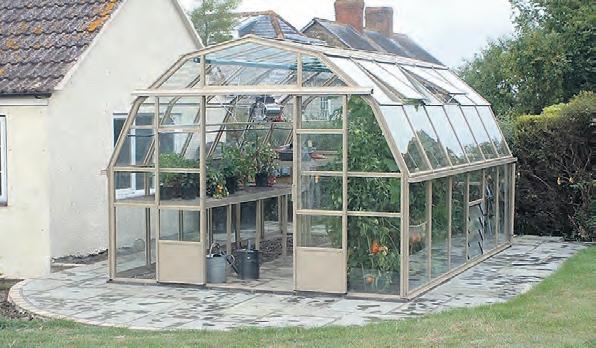
greenhouse you eventually choose will come down to two main factors – the area you have available and your budget.
It also comes down to experience and quality of service. One of the south west’s most experienced greenhouse supplier is Leigh Goodchild based near Bath who can supply almost all makes of greenhouses and have particularly extensive knowledge of Robinsons, Hartley Botanic, Gabriel Ash, Alton, Hercules and Simplicity structures. With over 30 years experience in the supply and installation of greenhouses the business prides itself on providing professional and practical advice where aesthetics, practicality, durability and creation of a space for plants and people can be combined.
www.leighgoodchild.com

High quality, extra strong greenhouses, individually designed and custom-built to suit your growing needs
It’s also the time of year when you don’t want all that hard work in spring to be wasted and that means making sure everything is growing at full steam and flowers and shrubs are looking their best.
At Country Gardener we are always on the lookout for great products and fresh ideas so here’s a few which might tempt you make the garden even more enjoyable and your home more pleasureable.
Dovetail Greenhouses is a second-generation family firm based in Tamworth, Staffordshire and serving the entire mainland UK. They were established in 1993 and since that time have evolved from offering a fixed range of quality standard buildings to specialising in the bespoke market.

Dovetail greenhouses are hand-made from their own heavy duty aluminium profiles to fit the exact requirements of each individual customer.
This approach allows them to replace an existing timber greenhouse without disturbing the original base or to design and build a new greenhouse into a very particular location.
For a personalised quotation contact Dovetail Greenhouses on 0121 3112900
Inside Out Buildings are a family run company set in the Blackdown Hills of Devon, who have been building bespoke buildings for over 10 years and have a wealth of knowledge across their team specialising in bespoke timber buildings such as log cabins, garden sheds, summerhouses, play houses, garden offices, workshops, garages and animal houses.
All the made-to-measure buildings are manufactured in-house by skilled woodworkers using sustainably sourced FSB approved UK timber. There is a wide range of buildings in the display area at our Dunkeswell premises, showcasing some of the timber buildings that we can provide, as well as accessories such as gates, fences, picnic tables and planters which we can produce in a range of shapes and sizes.
If you would like to get in contact and discuss your ideas please contact us on our email or phone.
Dunkeswell Industrial Estate, Timber Yard, Marcus Road, Dunkeswell Office: 01404 891404 / Simon: 07894 510133 or Ben: 07787 635623 info@insideoutbuildings.co.uk

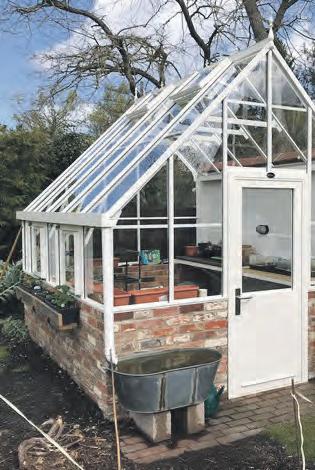




You can control your shrubs and climbers this year using Rivelin Glen Products uniquely designed Wire Anchors. They are quick and easy to attach to concrete posts (without drilling) to act as an ‘eye’ by threading wire through them to create a trellising system.
The Gripple Trellising System is ideal to use with the anchors as the wire does not stretch, takes up to 100kg load & has a life of up to 15 years. Multiple rows can be achieved with one length of wire and two tensioners. No more sore hands or sagging wires!
Rivelin Glen Products are the main stockists of the Gripple Trellising System.
Prices: Wire Anchors from £10.25 for a pack of three; Gripple Starter Kit - £20.25.
Details available at www.rivelinglenproducts.com
Email: info@rivelinglenproducts.co.uk Tel: 01246 462666
Concrete Post Fixings (Wire Anchors) & Easy Trellising System


Quick & Easy Solution to fix wires to concrete posts NO DRILLING - simply clamp the two halves together Three sizes to fit most concrete posts FREE UK DELIVERY Main Stockists of Gripple Trellising




Visit our website to view our other gardening accessories and gift ideas www.rivelinglenproducts.co.uk info@rivelinglenproducts.co.uk 01246 462666


We have a new exciting range of greenhouses coming out for the spring with a variety of different colours to brighten up your garden for 2025, along with a wide range of apex & pent design sheds with a number of different configuration options to choose from.
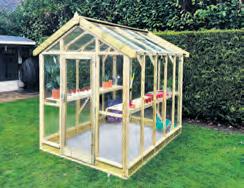


We are a family run company set in the Blackdown Hills of Devon, we have been building bespoke buildings for well over 10 years and have a wealth of knowledge across our team. If you would like to get in contact and discuss your ideas please contact us on our email or phone numbers below.

WE ALSO MAKE BESPOKE GARDEN BUILDINGS TO SUIT YOUR NEEDS FROM GARAGING, WORKSHOPS, GARDEN STORES TO CABINS.


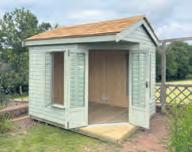
compiled by Vivienne Lewis
April is a special month, with spring truly under way, the Easter break and school holidays. Time to get out and enjoy the spring flowers and blossom in gardens opening for the National Garden Scheme that raises much needed funds for nursing and caring charities. Here’s a selection in the areas covered by Country Gardener and one or two just beyond. Check wherever possible before starting out as circumstances can force cancellations in private gardens. www.ngs.org.uk


Lamorna, Cornwall TR19 6XH
Opening for the NGS on Saturday 26th and Sunday 27th April, 2pm5pm each day, a beautiful three-acre cliffside garden overlooking Lamorna Cove, with mainly southern hemisphere shrubs and exotics with hydrangeas, camellias and rhododendrons. A woodland area with tree ferns is set against large granite outcrops. Garden terraced with steep steps and paths. Plenty of benches to enjoy the wonderful views. Admission £5, Children free.
Boughmore Road, Sidmouth, Devon EX10 8SJ
Opens for the NGS on Saturday 12th and Sunday 13th April, 2pm5pm each day. This stunning garden covering an acre is steeply sloping (lots of steps!) east-facing, providing ever-changing views across the valleys and towards the sea with lots of seating areas. Admission £5, children free. Also open other dates during the season, see the NGS website (above).
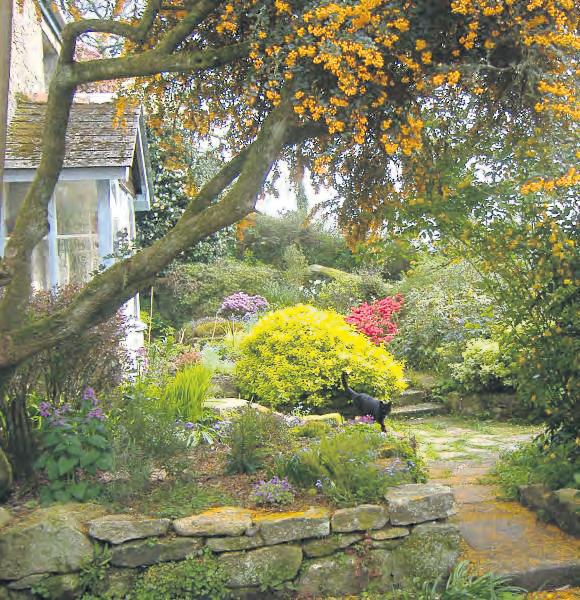
Old Hills, Callow End, Worcester, Worcestershire WR2 4TQ
Opens for the NGS on Easter Sunday 20th April, 1pm-4pm, a 1½ acre plantsman’s garden situated next to common land, there are informal mixed borders with a wide variety of hardy perennials where plants are allowed to self seed. Plant Heritage National Collections of Pulmonarias, Symphyotrichum novaeangliae and some hardy geraniums. Admission £5, children free.
Constantine, Falmouth, Cornwall TR11 5PY
Opening for the NGS on Sunday 27th April, 1pm-5pm, an intriguing isolated granite cottage in two acres, with a flower and vegetable garden, a bridge over a stream to a large pond and primrose path through a semi-wild bog area. Hillside with grass paths among native and exotic trees. Many camellias and rhododendrons. Mixed shrubs and herbaceous beds, wildflower glade, spring bulbs. Admission £5, children free.

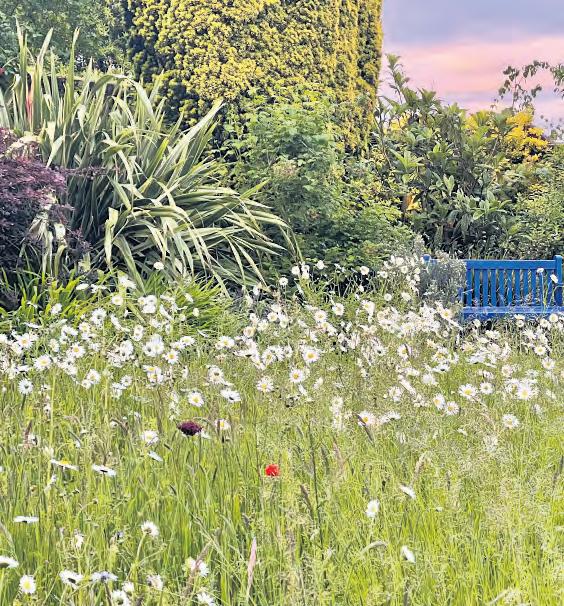
Denmans Lane, Fontwell, Sussex BN18 0SU
Opens for the NGS on Sunday 27th Aoril, 11am-4pm, created by Joyce Robinson, a horticulturalist and pioneer in gravel gardening and former home of influential landscape designer, John Brookes MBE. Denmans is a Grade II registered post-war garden renowned for its curvilinear layout and complex plantings. Year-round colour, unusual plants, structure and fragrance in the gravel gardens, faux riverbeds, intimate walled garden, ponds and conservatory. Admission £10, children £8.

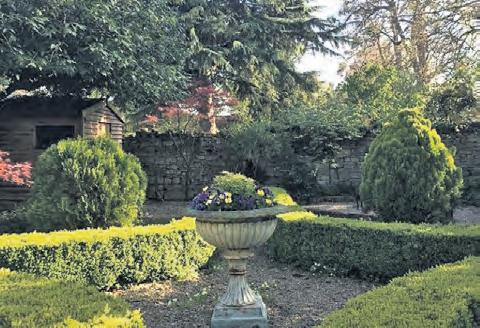

Mill Street, Prestbury, Cheltenham, Gloucestershire GL52 3BQ
A new opening for the NGS on Saturday 26th April, 1pm5.30pm, a semi-formal garden surrounded by mature trees, historic buildings and views of the church. with lawns and box hedges, many interesting trees and shrubs including an enormous magnolia, ginkgos, acers, lilac and Portuguese laurel. An historic dovecote leads to a secluded tranquil part of the garden. Admission £5, children free.
South Baddesley, Lymington, Hampshire SO41 5SJ
Opening for the NGS on Sundays 6th and 20th April, 2pm-5pm each day, a large parkland garden laid out in 1890 with distant views across the Solent to the Isle of. Wight. Walk along the extensive informal grass and moss paths down to the lakes, home to magnificent swans, with giant gunnera and bordered by fine rhododendron, magnolia and azalea trees carpets of bluebells. Glasshouses, swimming pool and other outbuildings are not open to visitors. Bring your own picnic and wear suitable footwear for muddy areas. Admission £5, children free.
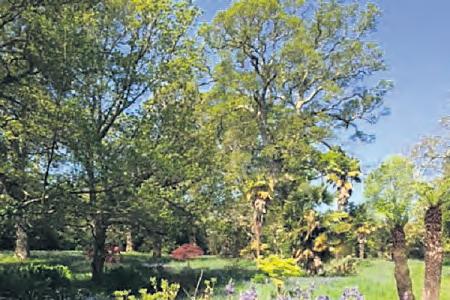



Hemyock, Cullompton, Devon EX15 3QS
Opens for the NGS on Good Friday, 18th April and Easter Saturday on 19th April, 1pm4pm each day (also 30th and 31st May), a cottage garden of lawns, colourful borders and roses, set within low flint walls with distant views. Slate paths lead through an acer grove to a swimming pool, amid scented borders, traditional ridge and furrow orchard, with a rose hedge, raised beds combine vegetables with flowers for cutting. Admission £5, children free.
Close Lane, Marston, Wiltshire SN10 5SN
Porlock, Minehead, Somerset TA24 8NU
Opening for the NGS on Tuesday 15th April, 2pm-6pm, this organic woodland garden of international renown stretches along a sheltered hillside and offers outstanding views over Porlock Bay. Moss-covered paths meander through a collection of ornamental plants that flourish beneath a canopy of oaks, hollies, conifers and chestnuts. Camellias, rhododendrons, azaleas, lilies, roses, clematis, and hydrangeas blossom among four National Collections. Admission £7, children £1.
East Orchard, Shaftesbury, Dorset SP7 0LG
A new opening for the NGS on Sunday 6th April (also Sunday 18th May) 2pm-5pm, a 2½ acre garden with thousands of daffodils along with newly planted trees and shrubs. The grounds surround a converted Methodist chapel dating from 1890 with the ongoing gardening project which continues to evolve; a large area is set aside to be wildlife friendly. Admission £5, children free.
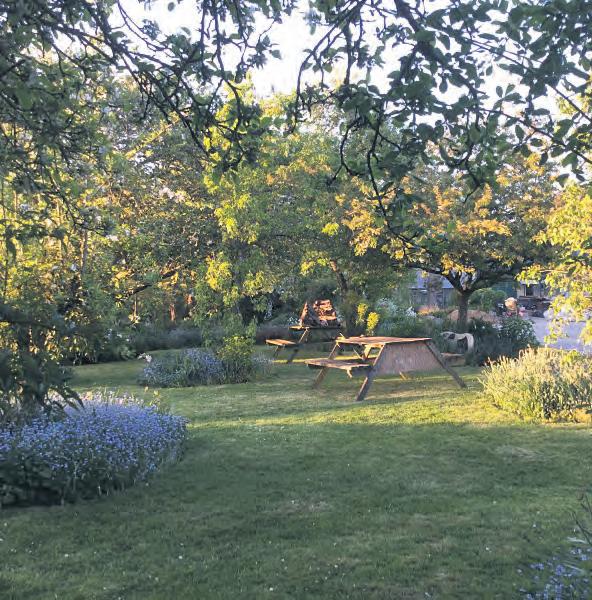
Opens for the NGS on Saturday 26th and Sunday 27th April, 1pm-5pm each day, a two acre flower arranger’s garden with daffodils, tulips and hellebores, herbaceous borders, orchard, vegetable garden, ornamental and wildlife ponds, lawns and naturalised areas. for year-round interest. Shrubberies and rose garden, other areas underplanted with bulbs or ground cover. Admission £6, children free.

Wicks Green, Longney, Gloucester, Gloucestershire GL2 3SP
Opens for the NGS on Saturday 12th and Sunday 13th April, 11am3pm, set in 1½ acres planted for year-round colour, surrounded by countryside, with flower borders, vegetable garden, a spring fed pond and mixed orchard with some
very old local pear varieties and beautiful blossom. The old bakehouse has been re-purposed for garden entertaining. Admission £5, children free.
Long Sutton, Hook, Hampshire RG29 1TB
Opening for the NGS on Saturday 12th and Sunday 13th April, 11am3pm, is set in 1200 acres of rolling farmland and wooded valleys, the main college campus set around formal lawns with mature paper bark maples, cedar trees, cherry trees, and magnolias; herbaceous borders planted with tulips, daffodils, and alliums. A South African inspired border runs the full length of the new science centre.
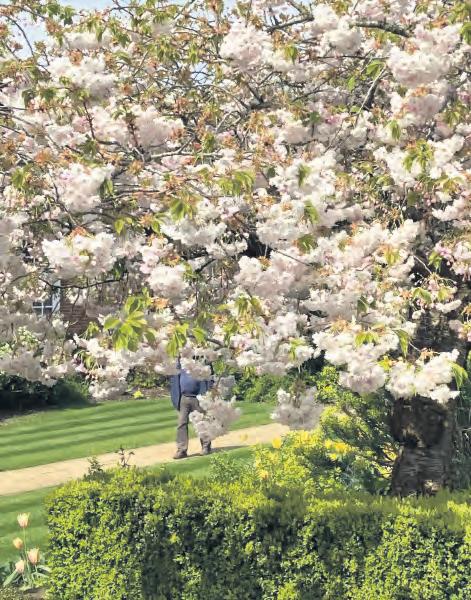
Corsham, Wiltshire SN13 0BZ
Opening for the NGS on Sundays 30th March and 13th April, 2pm-5.30pm, the park and gardens laid out by Capability Brown and Repton; large lawns with fine specimens of ornamental trees surround the Elizabethan mansion. An 18th century bath house is hidden in the grounds. Spring bulbs, beautiful lily pond with Indian bean trees, young arboretum and a stunning collection of magnolias. Admission £5, children £2.50.

Litton Cheney, Dorchester, Dorset DT2 9AH
Opening for the NGS on Sunday 27th and Wednesday 30th April, 11am-5pm, has steep paths leading to four acres of natural woodland with many springs, streams, two pools, one a natural swimming pool planted with native plants. The formal front garden, designed by Arne Maynard, has a pleached crabtree border, topiary and soft planting inc tulips, peonies, roses and verbascums; walled garden, kitchen garden, orchard and 350 rose bushes for a cut flower business. Entrance price £8.
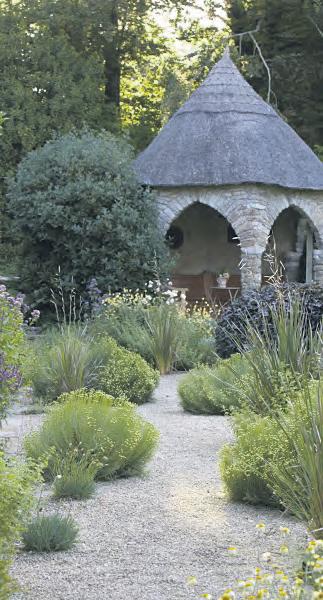


Stogursey, Bridgwater, Somerset TA5 1PU
Opening for the NGS on Sunday 13th April, 2pm-4.30pm, an historic woodland garden with many interesting bulbs including naturalised anemones, bluebells, fritillaria with roses, shrubs and fine trees, a paved maze and views of the Quantock Hills. An informal garden surrounds the house which dates from the 12th century, but was largely rebuilt in Elizabethan times. The 18th century park has fine trees and the walled former kitchen garden now includes small trees, shrubs and grass, with a rose garden and herbaceous border; many kinds of apple in the traditional orchard with daffodils planted in the grass, leading on to more woodland walks. Admission £7, children free.
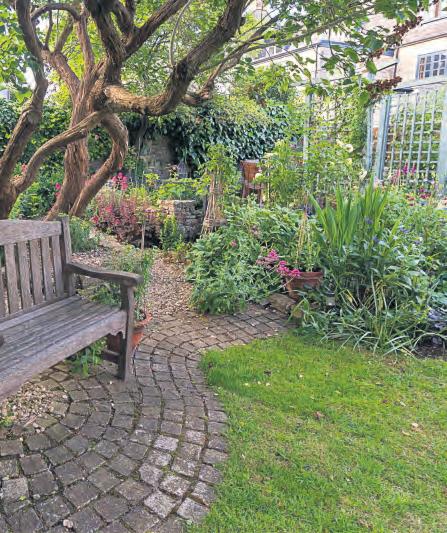
80 North Street, Winchcombe, Gloucestershire GL54 5PS
Opening for the NGS on Sunday 27th April, 1pm-5pm, a compact cottage style garden planted with a colourful display of tulips, and with perennials, annuals and climbers in the walled courtyard of a 17th century former coaching inn. Also a separate, productive, walled kitchen garden with espaliers and other fruit trees. Admission £4, children free.
If you have any gardening problems, queries or issues you would like help with, email them to editorial@countrygardener.co.uk

Should I put indoor plants out in the rain?
Carole Porter Exmouth
Yes, make the most out of the rain and use it to re-energise and refresh your indoor plants! Rain contains more nitrogen and oxygen than tap water, and because your plant roots are receiving them directly, you’ll notice them grow quicker and greener with rainwater. Plus, micro-nutrients and minerals, which are already present in the soil, are unlocked by the rainwater soaking through and then readily absorbed by the plant roots.
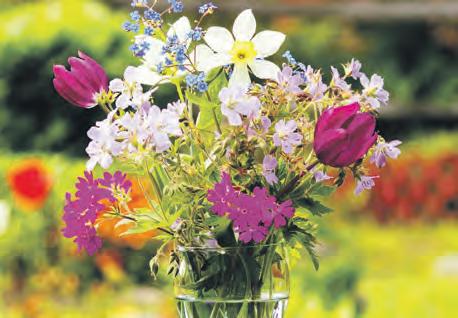

I don’t seem to be able to keep cut flowers very long before they start to fade. Are there any secrets to make they stay fresh for longer?
Katie Greene via email
There are a few things that should make them last longer. Changing the water more frequently will help and remember to re cut the stems each time you do it.
Remove any foliage below the water line. Make a fresh cut below the water line about 10cms down the stem so that you are cutting both foliage and flowers.
Don’t place your cut flowers near sunny windows or radiators or they’ll fade quickly! The lower the temperature the better which is why cut flower displays placed in cool churches last so long.
I have read how great it is to leave grass clippings on the ground for soil nutrients. We pick up our grass clippings and still have too much thatch. What are we doing wrong?
Derek Hall sent by email Thatch in lawns is not caused by lawn clippings. This is a common misbelief. It occurs when dead material builds up from the bottom of the lawn, rather than the top. Common causes of thatch are overwatering or overuse of high nitrogen fertiliser or mowing with the blades too short. Leave the grass cuttings on the lawn- especially in the spring and autumn.

I have a lilac tree. It’s about nine feet high and I think growing fast. I have it planted roughly six feet from my neighbour’s wall. I have now had three conversations with them that they are worried the roots will damage their foundations. Can you tell me if this will do that?
Marlene Gordon Martock
It is highly unlikely that the lilac will cause damage to a foundation. They have very nonaggressive root systems and this is why you often see them used as foundation plants. The only way that it could be a threat (and even then, the plant would probably die before it did damage) would be if the roots were restricted tightly, as in there were only a few feet for the roots to grow in. That does not sound like the case where you are, so the lilac is not a threat.
I have tried growing a lemon tree in a pot and all the leaves keep dropping off. This latest one is the third lemon tree that the same thing is happening to. The other two died, and now it looks likely to happen to this one if I don’t come up with a solution.
Carla Davies Southampton
The most obvious problem with any citrus trees is watering. Leaves drooping off is normally caused by letting the soil get too dry. Citrus trees are funny because they hold onto their leaves when they are under watered and then drop the leaves once water returns. You need to keep these plants evenly always watered to avoid this.

I live in the city but want to do more for wildlife. Are there any first steps you would recommend for city gardeners with limited space who would love to create a welcoming habitat for wildlife?
Anna Trent Bristol
Whatever your space you can help wildlife. On balconies and roof gardens you can grow Mediterranean herbs in pots and let them flower for pollinators, leave a dish of water for passing birds and small mammals to drink from. If you have a small garden, then grow flowers but if you have space add in a few native shrubs and ‘weeds’ that moths will lay their eggs on. A container pond may attract aquatic invertebrates and frogs while a patch of long grass will help beetles and moths, which are food for many species further up the food chain. Taken alone, your garden won’t do much but linked with other gardens it will become part of a much wider, wilder landscape, which will help huge numbers of species.
I have a small rose bush that was beautifully growing in its original pot. There were lots of new growth and buds coming up. However, it got too big for its small pot, so I transplanted it to a larger pot and gave it fresh potting soil. Since then it just looks as if it is suffering and not healthy .Now, the buds are gone and the new leaves that are growing are yellowish with a red lining around the edges. Why is this happening? Do I have a diseased rose? Lack of nutrients? Any advice would help.
Zena Richards Cheltenham
This sounds like transplant shock and many roses just don’t like to be moved and can take a season to recover. You should also investigate phosphorus problems. Maybe make sure your compost has enough phosphorus in it to sustain the growth system. Mulch it well and try a good quality feed. The damage shouldn’t be permanent.
If I do not want my tomato plants to grow to a height of four feet (maximum), what can I do?
Mark Ellison Boscombe
You should plant bush type tomatoes that only grow to three feet, or you can prune the tops off when they reach the desired height. The best method if you already have the plant established is training the plants sideways. Make use of trellising and cutting the tops off plants to force branching down the sides. As well as keeping it shorter, it can also improve the yield of the fruit. The trade-off here is the time it takes for recovery after each cut. They can still attempt to bear fruit but won’t really get going until they have had time to heal and settle. Hope this helps some.
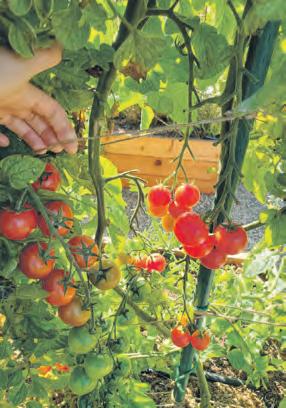
I want to do some experimenting on changing hydrangea colour. If the tree is already grown, can I still change the colour of the flower?
Hetty Rooper Liss
Yes changing the colour is fairly easy. After you have decided that you want to make your hydrangea change colour, it is important to understand why hydrangea colour can change. The colour of a hydrangea flower depends on the chemical makeup of the soil it is planted in. If the soil is high in aluminium and has a low pH, the hydrangea flower will be blue. If the soil has either a high pH or is low on aluminium, the hydrangea flower colour will be pink. So, it is simple enough, you just have to change the chemical composition of the soil. If the pH is above 6.0, then the soil has a pH that is too high and you need to lower it (also known as making it more acidic). Lower the pH around the hydrangea bush by either spraying the ground with a weak vinegar solution or using a high acid fertiliser, like those made for azaleas and rhododendron. Remember that you need to adjust the soil where all the roots are. This will be about two feet beyond the edge of the plant all the way into the base of the plant.
When is the best time to plant rose bushes?
We have a new garden project this summer and would like some roses on the patio.
Siohan Okrra sent by email
For roses you want in pots and are growing and blooming, usually the end of May is okay, but check your location for the last hard frost date in your area. If a hard frost is coming once it’s been planted, protect the bush with fleece. Roses are expensive and a spring frost could do a lot of damage.

Three years ago, I planted two different types of fig trees in the same area. (within two feet of each other) One plant was from my brother’s trees in Devon -type unknown. The other came from Otter Nurseries and was a dark type. The one from my brother has produced figs for the last two years while the second has yet to produce any figs. My guess is that I need a second plant of the same kind to get figs on the second plant.
Martine Cordon Exeter
Most fig trees need to be between three and five years old before they can produce fruit. I would say that your Devon variety needs a few more years before it is mature enough. The one from your brother’s home may have been older when you got it or it may have come from a cutting from more mature wood or it is simply a variety that has less time to full maturation. For the one that is not producing, give it another year or so. Just in case, add a bit of bone meal. Figs are very susceptible to too much nitrogen, which can produce lots of foliage and little fruit. Bone meal will provide phosphorus, which helps boost fruit production.
Plant nurseries are at the very heart of our day-to-day gardening life offering greater choice of specialist plants through the selection of choice, value for money, advice and low risk of imported disease

In recent years a new generation of garden hunters has appeared. They may not be thrashing through the jungles of faraway countries but their passion to find new plants, new things to grow is strong. For these new hunters are the ordinary gardeners of the UK who are out and about demanding high quality, great value specialist plants which offer us something different in our gardens.


The better-informed gardener now wants to spend time making sure they have the right plant for the right task and need help and advice. All of which throws the spotlight on specialist plant nurseries. Plants purchased from any specialist nursery can save you time and frustration – and chances are, they’ll live longer and look better. Nurseries use top grade soil media when potting their plants. These plants tend to live longer and look more appealing because skilled gardeners have grown them and cared for them.
Generally, specialist nurseries offer a greater selection to choose from.
Big-name retailers often only carry bestsellers limiting choice, whereas a nursery offers a wide selection.
You will typically find healthier plants at nurseries. They have endured less handling and have been grown and nurtured in an optimal environment with the right care, and under expert supervision. The healthier plants are, the better they tend to adjust when replanted, and the better they grow.
At a local nursery, the plants are at the centre of everything the team does. This means that you have first-hand access to knowledgeable staff who can help you with valuable advice on specific plants, answer any questions you may have, and make relevant suggestions based on your needs.
In addition to the wider selection on offer, a specialist nursery that cultivates its own plants will generally be able to provide more choice plus advice regarding indigenous, and specifically native plants. Native plants are a great buy, because they are already adapted to the soil, light, and climate.
Foreign pests pose a huge risk, as they are often able to spread rapidly and cause significant damage. Buying from a local nursery that grows their own plants eliminates this risk.
Koirin, the Dorset based Rhododendron & Azalea Centre have an international reputation as specialist growers of rhododendrons and azaleas and at this time of year have a wonderful display of plants to browse.
The nursery is open Mon-Fri 9am-4pm all year round, Sat 10am-4pm Apr-May. The nursery does not accept cheques.
Crossroads Nursery, Woodlands, Nr. Verwood, Verwood Road, Wimborne BH21 8LN Tel: 01202 824629
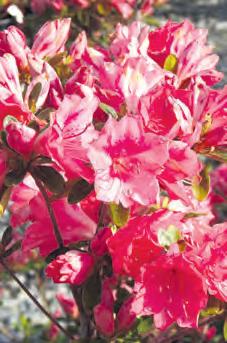

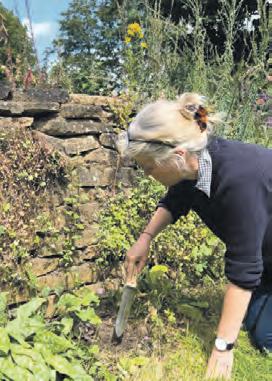

As a team of wildflower experts, we’ve been growing, digging, and planting for more than 30 years. We’ve planted thousands of wildflower plug plants and bulbs, and we’ve probably tried every tool there is; but we’ve never been so impressed by a tool as we were when we first used the HORI HORI KNIFE. This tool has truly transformed our gardening experience— it’s now our absolute favourite and one that we never garden without.
If you’ve never used a HORI HORI before, let me give you a quick rundown. Inspired by traditional Japanese gardening tools (the word “Hori” is Japanese for “to dig”), the sharp blade of the HORI HORI knife makes it the perfect digging tool for planting bulbs and plug plants. Simply use the blade to cut down into the soil, then wiggle it back and forward to create a hole at the perfect depth for your plugs and bulbs. The inch and centimetre measurements on the blade help you to plant at the right depth, which is key for healthy, thriving plants. The process is quick and easy—no more struggling with a trowel! Whether you’re planting daffodils in the lawn, crocuses in a flowerbed, or wildflower plug plants in a meadow, the Hori Hori makes it effortless to get your wildflower bulbs and plugs exactly where they need to be. It’s made planting so much quicker and easier for us – we honestly couldn’t recommend it more!




And the HORI HORI isn’t just for digging and planting! We use it for almost everything in the garden: weeding lawns, flower beds and paths, cutting through tough roots, light pruning, getting plants out of pots, splitting bulbs, and even slicing open compost bags and trimming twine. It’s such a versatile tool – think of it as a Swiss army knife for the garden - that we really can’t imagine gardening without it.
MEADOWMANIA’S HORI HORI stands out with its ergonomic wooden handle that feels great in your hand, even after hours of work. The high-quality stainlesssteel blade is sharp, durable, and rust-resistant, and makes light work of tough gardening tasks. Plus, it comes with a handy sheath and belt loop, meaning you can carry it safely and always have it to hand when you need it most.
With minimal care – just keep it clean and dry and occasionally oil the wood handle – the MEADOWMANIA HORI HORI will last for years, becoming your trusted companion in the garden season after season.
Happy gardening!

At Meadowmania, we’re passionate about helping individuals, companies, and communities across the UK create thriving, biodiverse landscapes. From native wildflower seeds to wildflower plants and bulbs, we provide everything you need to cultivate sustainable, wildlifefriendly habitats. Our mission is to inspire and equip people to make a real difference for nature, bringing vibrant meadows to life in gardens, community spaces, or larger landscape projects.
As a special treat for readers of Country Gardener, we’re offering 10% off our Meadowmania Hori Hori knife during April. Just use the code HH10 at checkout at www.meadowmania.co.uk

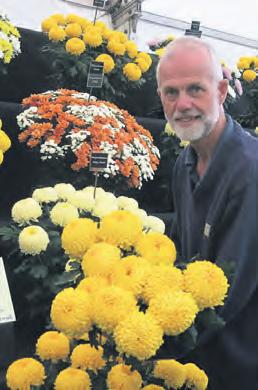
Chrysanthemums Direct are the UK’s leading grower and supplier of Chrysanthemum plants to the public. They stock over 415 varieties covering a wide range of different types, including exhibition and garden hardy cultivars. They sell via mail order and have developed a sustainable packaging solution, which ensures that you receive top quality plants, within 24 hours of dispatch, from their nursery in Cheshire.
Look out for them at the top flower shows around the country this year, including Chelsea and the new RHS show at Wentworth Woodhouse. Also, Harrogate, Malvern, and Gardeners’ World Live at the NEC. They will have a good selection of plants available to buy at each show.
Details of all the products we sell are available on their website www.chrysanthemumsdirect.co.uk

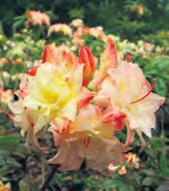


Koirin, Crossroads Nursery, Woodlands, Wimborne, Verwood Road, Dorset BH21 8LN (Near Verwood) Tel: 01202 824629 enquiries@azaleacentre.co.uk


Order your plants now for delivery in May. ORDER ONLINE or catalogue available by request.



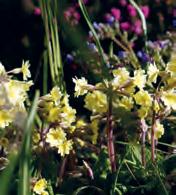
Have you ever booked onto one of our courses? Take a look at our new website for details of the courses we have coming up this year - www.oldcourtnurseries.co.uk/events Also open 10TH APRIL and 8TH MAY for the National Garden Scheme please book at www.ngs.org.uk
Tel: 01684 540416 www.oldcourtnurseries.co.uk
Barthelemy & Co – the Japanese maples specialists
Barthelemy & Co near Wimborne in Dorset was established by a French nurseryman almost a century ago and the Skinner family now specialise in propagating and growing Acer palmatum –or Japanese maples as they’re known.

Throughout spring, summer and autumn the delicate foliage of the acer presents exquisite shadings of Mother Nature’s gold, pink, purple, green, yellow, orange and red. Acers are a delightful addition to anyone’s garden, giving an aura of peace and tranquillity. The ten-acre nursery at Stapehill has a huge collection of Japanese maples to choose from and expert staff are on hand to help select the right variety and to offer advice about caring for the trees in future.
Over 100,000 acers are produced at Barthelemy & Co and Co every year approximately 15,000 - 20,000 of them are grafted named palmatum varieties, as one of the largest specialist growers of their kind.
Barthelemy & Co, 262 Wimborne Road West, Wimborne, Dorset BH21 2DZ
Tel: 01202 874283 www.barthelemymaples.co.uk
The Picton Garden is perhaps best known for its autumn displays particularly the wonderful michaelmas daisies. But a visit in April offers something really different and a chance to explore the smaller treasures that thrive in the woodland areas of the one-and-ahalf-acre garden.
You can visit and enjoy a wander alongside wood anemones, epimediums, trilliums and more. It’s also a great time to purchase a few new treats for the garden from the adjoining Old Court Nurseries.
Walwyn Road, Colwell WR13 6QE Tel: 01684 540416 www.autumnasters.co.uk

Holmes Chapel Road, Over Peover, Knutsford, Cheshire. WA16 9RA
Telephone: 0800 046 7443 sales@chrysanthemumsdirect.co.uk
2025 Catalogue available online now or, contact us to receive your FREE paper copy.
The widest range available in the U.K. with over 415 cultivars, including a choice selection of hardy garden (Korean) varieties, plus many others suitable for the garden or exhibition.
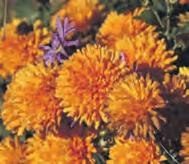
www.chrysanthemumsdirect.co.uk

We produce and grow the largest selection available in the UK. Plants are pot grown and suitable for garden, patio or bonsai.
Visitors welcome Mon-Sat 9am-1pm & 2pm-4pm
Barthelemy & Co (DCG), 262 Wimborne Rd West, Stapehill, Wimborne, Dorset BH21 2DZ
Tel: 01202 874283 enquiries@barthelemymaples.co.uk www.barthelemymaples.co.uk
Growers throughout the Cotswolds will benefit from a new guide and free expert advice service which focuses on using peat-free compost launches
As the growing season approaches, a number of expert organisations - retailers, manufacturers, growing media manufacturers, growers and conservation charities have combined to explain how to grow successfully using peat-free compost
It’s a bid to accelerate the UK’s transition away from peat.
The 20 organisations, brought together by environmental innovator Sizzle, include DEFRA, the Horticultural Trades Association, Garden Centre Association, British Growers Association and the RHS.
This comes in the wake of recent legislative delays and new research commissioned by Sizzle which reveals that while 6per-cent of gardeners care about sustainable composts, only 30per-cent say they consistently buy peat-free.
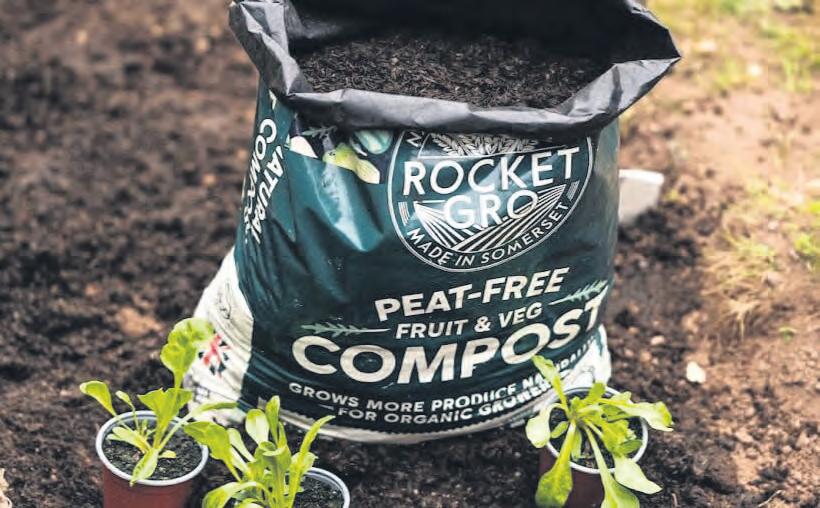
Lack of education and familiarity with how to use peat-free compost are key factors. The research suggests over one in five gardeners (from novices to experts) are confused about the differences between compost types and what makes them sustainable. Additionally, 43 per-cent of gardeners stick to composts they know, a trend especially prevalent among those over 55 and more experienced gardeners.
The new guidance aims to alleviate these concerns, giving consumers advice on choosing the right compost for their needs and addressing common issues with peat-free products, including overwatering, underfeeding and incorrect storage.
Nature Minister, Mary Creagh, said: “Our peatlands play a crucial role in our ecosystems, acting as our largest terrestrial carbon store, as well providing vital habitats for our wildlife.
“This kind of collaboration across the horticulture sector is key to protecting our peatlands for the future. Gardeners are keen to do their bit to preserve our wonderful landscapes and this new guidance will help to bridge the knowledge gap and make peat free gardening achievable.”
Peter Burks from The Garden Centre Association exclaimed “The Garden Centre Association is determined to provide our customers with the best advice on how to use these new peat free composts successfully. It is so important for all gardeners to have confidence in the products that are now available to them to ensure they continue having a great time growing plants in their homes and gardens.
Over 80per-cent of peatlands are damaged, and these ecosystems are critical for biodiversity. Despite this and 88 per-cent of amateur gardeners supporting a complete retail sales ban on peat-based products, many gardeners continue to buy peat-based compost. The guide represents advice from the sector and it also comes with an email helpline where gardeners can email their bespoke questions on how to garden peat-free
Email to: peatfree@rhs.org.uk
• One in five gardeners confused about compost types.
• Over 55’s show some resistance to peat free.
• 88% of gardeners support retail sales ban on peat.
• Many gardeners still buying peat based compost.
• Peatlands are natural boggy habitats that store over twice as much carbon as all the world’s forests combined, despite covering an area ten times smaller. In fact, peat bogs store twice as much carbon as all the vegetation on the planet put together. This makes them the most efficient carbon sink on land.
Welcome to our April Time Off and details of gardening club and association events, shows and meetings over the next few weeks in the Cotswolds. This is a free service in Country Gardener and if you would like any events given some promotion write to us at timeoff@countrygardener.co.uk

April
8TH
Broadstone Horticultural Society A BRIEF HISTORY OF GARDEN DESIGN - HELEN MILNE www.broadstonegardeningclub.com
Slimbridge Gardening Club ‘GARDEN DESIGN’ - PENNY DOMMETT Email: carole.jeffes@slimbridgegc.plus.com
West Malvern Garden & Nature Club ‘BRITISH ORCHIDS’ - MIKE WILKINSON
Email: greenbank@icloud.com 12TH
The Alpine Garden Society, Severn Hall, Three Counties Showground REGIONAL SPRING FLOWER SHOW & PLANT FAIR www.alpinegardensociety.net 14TH
West Moors Horticultural Society ‘DORSET THROUGHOUT THE YEAR’ - PAUL STURGESS Details on 01202 871536 16TH
Chipping Norton Horticulture Association ‘CREATING A GARDEN USING STATUARY’ - CHRISTOPHER STOCKWELL Email: secretary@cnha.uk
Winchcombe Gardening Club ‘INNOVATION & AUTOMATION IN PRODUCING PLANTS IN THE 21ST CENTURY’ Details on 07836 297168
Berkeley Gardening Club
‘NATIONAL GARDEN SCHEME, GLOUCESTERSHIRE
- VANESSA BERRIDGE
More details 01453 810607 17TH
Newest Gardening Club
‘AULDEN FARM FROM CONCEPTION TO CHAOS’ - ALUN & GILL WHITEHEAD
Details on 01531 820761
West Down Garden Club ‘VEGETABLE PRODUCTION IN A SMALL PLOT’ - PETE ADAMS, RHS ROSEMOOR
Details on 01271 865554 26TH
Amberley Gardening Club PLANT SALE
Forecourt of Holy Trinity Church/ Amberley Shop & Cafe 10am12.30pm

Are you part of a garden club or society?
Please send us your diary for the year - we’d love to include your talks and shows
Send them into us by email giving us 10 weeks notice of the event: timeoff@countrygardener.co.uk or by post to: Mount House, Halse, Taunton, TA4 3AD.
Cotswolds gardeners are being encouraged to help the humble hoverfly .The Royal Horticultural Society and The Wildlife Trusts are calling on gardeners to help save hoverflies. This fly family is the second most significant pollinator after bees – some species of hoverfly are known to visit more flowers than bees.

These insects are unsung heroes of many of our ecosystems. Hoverflies visit 52 per-cent of crops globally which they either pollinate or protect by eating sap-sucking aphids. Additionally, they pollinate wildflowers, are food for birds and even help break down organic matter in gardens.Yet, intensive agriculture, harmful pesticides, urban development and climate change have all taken their toll. Hoverflies are masters of disguise. True flies have only one pair of flight wings (whereas bees and wasps have two) and they make up over 280 of the 6,000 fly species in the UK. It can be easier to identify them by their behaviour than their looks, because they hover or even zigzag around plants.
South Western Railway has teamed up with South and South East in Bloom to celebrate the many green-fingered volunteers and biodiverse stations. SWR, which operates across Berkshire, Gloucestershire Devon, Dorset, Hampshire and the Isle of Wight, Somerset, Surrey and Wiltshire, is sponsoring the 2025 edition of South and South East in Bloom and has introduced a special category, Celebration Stations.
South and South East in Bloom is one of 16 regions across the UK that make up the annual nationwide gardening competition ‘Britain in Bloom’.
RHS Malvern Spring Festival, the first major RHS show of the year, returns to Three Counties Showground, Malvern from Thursday 8th to Sunday 11th May with a four-day horticultural extravaganza, including a real focus on cuttingedge, accessible and sustainable indoor gardening.
The theme for this year’s RHS Malvern Spring Festival, ‘Plants & People’, invites both new and returning visitors to explore the myriad of ways in which plants impact our lives – from the food we eat and the air we breathe, to the fascinating impact they have on our mental and physical wellbeing. Indoor gardening is a key area of focus at this year’s RHS Malvern Spring Festival, and the Festival of Houseplants, in collaboration with Green Rooms Market, will be back after its successful debut last year, offering the opportunity for visitors to immerse themselves in a treasure trove of indoor plants.
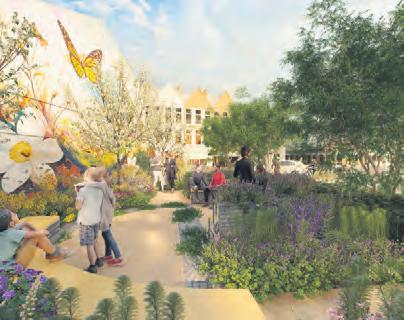

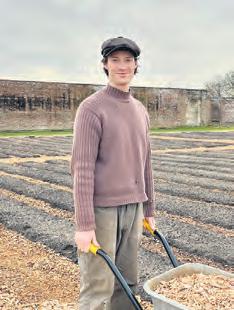
with the aim that they will be self-sufficient by 2027. The extension of the space is an exact doubling, or mirroring, of the existing Kitchen Garden, from one acre to two acres, plus three greenhouses for growing tomatoes and propagation. The new area consists of 80 new, no-dig compost beds, in between which are woodchip pathways, to allow visitors to walk and interact with the abundant vegetables, herbs and flowers that will be growing there.
As well as producing larger quantities of the vegetables and herbs already grown at Blenheim Palace, such as heritage beetroots, carrots, squash, chard and cavolo nero, the Gardens team are hoping to establish perennial vegetables such as asparagus and rhubarb - as well as niche varieties including Welsh onions and Korean mint. Harrison Fannon, vegetable gardener at Blenheim Palace, said: “In order to meet the demand of the kitchens we need to grow more vegetables, and to achieve selfsufficiency at Blenheim in terms of fresh produce would be a big turnaround for the Kitchen Garden in three years.
He added: “The original purpose of building the Walled Garden, which is one of the largest in the country, was to support the intensive production of fruits and vegetables by blocking wind, keeping out animals and intensifying the sun’s heat.”
The Blenheim Estate has stepped up to help the Irish national sport of hurling, by supplying hundreds of ash trees which are needed to make the hurling sticks or ‘hurleys’ used by players. Ireland’s own stock of the wood has been decimated by ash dieback, Hymenoscyphus fraxineus, a lethal disease first detected in the UK and Ireland in 2012.
Richard McCarthy, an Irish hurley maker who sources ash for many of the country’s top manufacturers including Star Hurley in Kilkenny, has been working with James Hunter, Rural Property Manager at Blenheim Palace, on a deal which will see around 1,000 ash tree ‘butts’ harvested from the Blenheim Estate, which will in turn be used to make between 5,000 to10,000 hurleys.
Although thousands of acres of ash trees were planted in Ireland 30 years ago, ash dieback has decimated the stock, particularly the younger trees
Hurling is not the only sport which buys wood from the Blenheim Estate; for the last seven years, Banbury-based English Willow has been sustainably sourcing Cricket Bat Willow trees from the estate. In 2018, the firm purchased and felled a significant number of trees from the estateenough to produce around 2,300 top grade cricket bats for the global cricket industry - and replaced them free of charge. Each year it supplies around 100 cricket bat willow ‘whips’ to replace those harvested for bats.
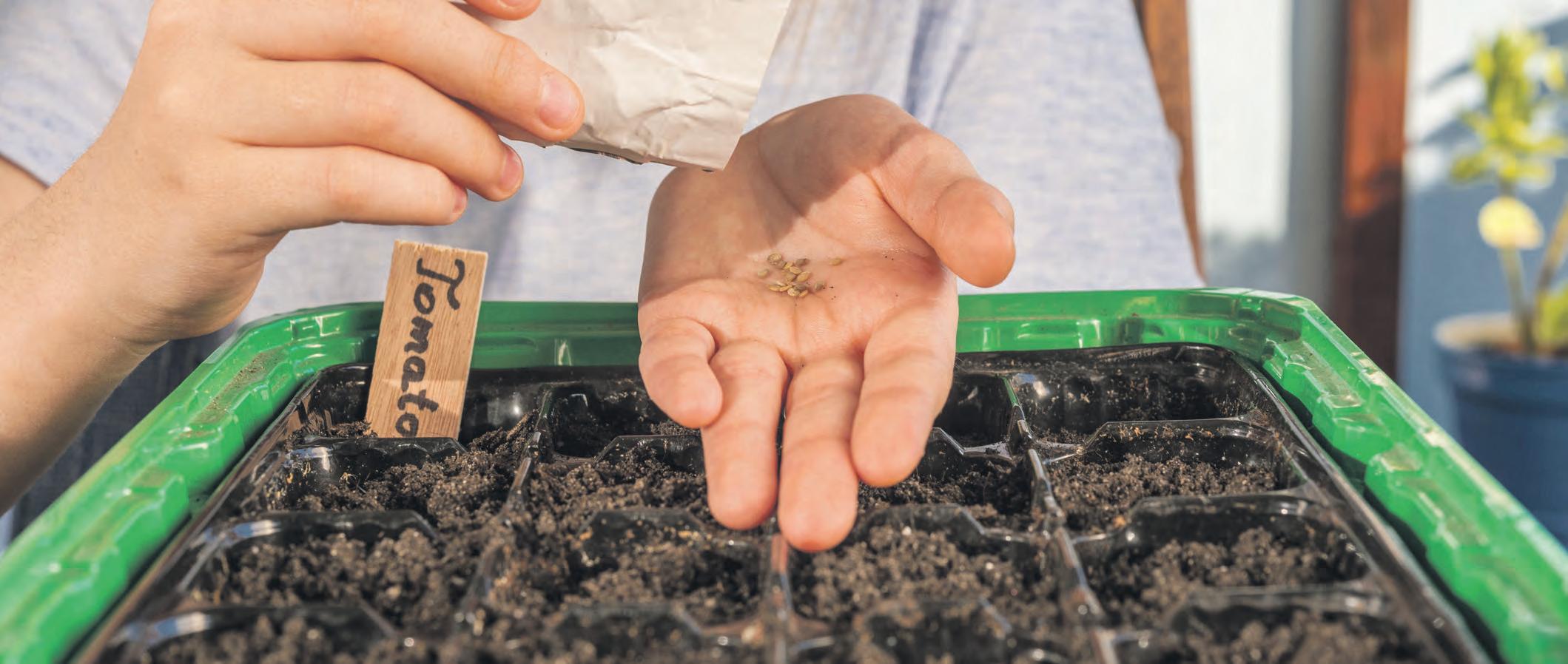
Now is the time to buy seed packets and get sowingit’s cheaper, more rewarding and a lot more fun
Sowing seed is one of the most easy, satisfying, and cheap ways to get growing. March and into April is the perfect time of year to start most of the seed sowing. Some people start early in autumn, some start seeds off in January or February, but the next few weeks is fine, especially if you don’t have a greenhouse. It should be starting to get a bit warmer which means that seeds germinate faster and you’ll soon catch up.
So many more gardeners now grow from seeds and they more are opting for annual flower seeds, meaning that in one year the seed will germinate, grow, flower, go to seed and then die. Like Gertrude Jekyll, they don’t like to see bare soil. Jekyll seemed to follow the philosophy that more is more, so we know she loved an abundance of plants!
You should use peat-free seed sowing compost which is lighter and finer than other composts. It’s normally made of a mixture of coir (made from coconut husks), bark and compost. The compost needs to be low in nutrients and have good drainage, but at the same time hold enough water. The seeds themselves have enough nutrients and energy stored to be able to germinate and provide the first leaves of germination, as long as they have access to light and water.
Once they’ve produced their first true leaves they’re ready to be pricked out into a compost with more nutrient content, sometimes called ‘potting on compost’.
Very simply, seeds are embryonic plants waiting to get out. They come complete with their own food supply to start them off, at least until they can put down roots and draw nutrients and water from the soil.
All seeds need water, oxygen, the correct amount of light and the right level of warmth to germinate. If your seeds need to be started indoors or under cover, it doesn’t necessarily mean you have to invest in costly equipment or a heated greenhouse. Supplying enough warmth could be as simple as a temporary home in the airing cupboard or a sunny windowsill.
• Seeds trays and pots should be thoroughly cleaned before use.
• Always use fresh, good quality compost.
• Beware of saved seeds. Some remain viable for a year or more after the packet seal has been broken, while others, like parsnips, don’t keep well.
• Most seeds germinate best if the tray is covered with a sheet of glass or plastic to retain the moisture in the compost.
• As soon as the seedlings emerge, reduce the daytime temperature to about 65°F (18°C) and position them away from direct sunlight.
• You’ll need to gradually harden off these plants for about two weeks before they’re moved into their final outdoor positions.
Some vegetables, hardy annuals and tree seeds should be direct-sown into a special ‘seed bed’ rather than into their final positions. The soil should be free of weeds, large stones and debris and be broken down as finely as possible.
Sow your seeds into v-shaped drills made to the recommended sowing depth for each particular variety. Create taut lines with string to help you keep your drills straight. It makes weeding easier as the plants grow.
Many hardy annual flower seeds can be sown directly where you want them to flower. The soil should be a minimum temperature of 50°F (10°C) when you sow. Annuals don’t need a nutrient-rich soil, so a dressing of artificial fertiliser isn’t necessary. All soils and plants benefit, however, from organic matter that has been dug into the top few inches of the soil early in the year. When sowing a range of annuals, sow the seed in patches rather than in regimental lines.
Remove weeds and rake the soil to a fine tilth, then mark out the groups with a trickle of silver sand or flour. Annuals need only a light covering of soil which can either be sieved over the seeds or gently raked over and then firmed with the flat face of the rake.
When the seed has germinated, thin out any overcrowded seedlings as soon as possible. A further thinning out might be needed when the plants have developed several pairs of true leaves.
When seeds germinate, the first leaves to appear are the cotyledons or seed leaves. These are usually a pair of oval, fleshy leaves that bear no resemblance to the mature leaves of the plant.
Removing the tiny seedlings from the sowing tray into containers of a good universal compost can be a delicate business.
Never handle seedlings by their stems, which bruise easily. Always use their seed leaves.
Some seeds benefit from pre-treatment before sowing, or from being sown in a particular way. This pre-treatment is rarely vital to success, but your seeds might take longer to germinate if you don’t do it.
Soaking is beneficial in two ways; it can soften a hard seed coat and also leach out any chemical inhibitors which might prevent germination. Anything from one to three hours in water which starts off hand-hot, is usually sufficient. If soaking for longer, the water should be changed daily.
Unscramble
How many of these quite tough questions can you manage to get right?
1. Which Kings of England lived at Kew Palace at Kew Gardens?
2. When should beans be planted to bring good luck?
3. What is the most common bird in the UK?
4. Which flower is also the goddess of the rainbow in Greek Mythology?
5. The Major Oak is one of the most famous and most visited trees in England. Where is it to be found?
6. What fruit comes in varieties of Orlo Blanco, Pink, Ruby Red, Thompson and Pink?
7. What were brought to Britain from Germany by Sir Charles Isham in 1847?
8. Helianthus is another name for which flower?
9. Which flower grown and picked at Osborne on the Isle of Wight has been carried by royal brides since the 1850’s?
10. What tree contains all five vowels?
This month's Word Search is based on gardening terms

APIARY
BALUSTRADE
BAREROOT
BEE HOTEL
BOG GARDEN
CORM
CLUMP
COPPICE
CORBEILLE DEADHEAD
Our popular gardening themed crossword is compiled by Saranda which over the past year has become enormously popular with readers. The winning entry to be drawn by us will receive £100 of RHS gift tokens. Completed entries should be sent to Mount House, Halse, Taunton, Somerset TA4 3AD. Closing date Friday, 25th April.
RAISED BED
1. Tall tropical plant cultivated for its oil (6)
4. Tall West African hardwood trees (6)
8. Farmland or garden left uncultivated (6)
13. A tapering medieval dagger (6)
14. English gardener and naturalist (15701638) (4, 10)
16. Common name of Colutea arborescens (7-5)
17. To make someone feel resentful (8)
18. Removing the main body or stalk of a plant or shrub (8)
19. Validate or verify (12)
21. A leaf composed of four leaflets (13)
23. A small wooded hollow (4)
26. Having a margin finely notched like certain leaves (9)
28. Relating to the country where Oreomecon nudicaulis grows (9)
31. Line behind which players throw darts (4)
33. Name sometimes given to the elephant foot yam (8, 5)
37. The art of garden cultivation and management (12)
38. The existence of a tree (8)
40. Payment from public funds for poorer people to go to court (5, 3)
41. Plant with double flower heads and a spiky appearance (6, 6)
43. People who find water using a divining rod (14)
44. Ailanthus altissima or Tree of ______ (6)
45. White poplars (6)
46. A black liquid used in lithography (6)
47. Grand National hero who was the apple of Ginger's eye! (3, 3)
DOWN
1. Juneberry, saskatoon or sugarplum (8)
2. Soldierly or army rabble (11)
3. Fruit of a tree native to New South Wales and Queensland (9, 3)
5. Spanish for flowers (6)
6. Buttercups belong to this genus (10)
7. The fruit of the true service tree (4)
9. A hormone that adapts plants to suit different weather features (9)
10. Strand of conducting vessels extending from the stem to the base of the leaf (4, 5)
11. Common name of Cicuta, a genus of poisonous plants (5-7)
12. Common name of Aplectrum hyemale, an orchid (4, 3, 3)
15. A worker who thins out and trims trees (6)
20. Old pop group perhaps named after the genus Ilex (7)
22. Ornament resembling a small flower (7)
24. This genus comprises about 200 species of plants known as figworts (12)
25. Family name of the poppy (12)
27. These flowers are also called laceleaf and pigtail plants (10)
29. Name sometimes given to Trifolium repens (5, 6)
30. Caribbean trees sometimes called West Indian locusts (10)
32. Alternative name for Ruta graveolens (4, 5)
34. Pierced with small holes (6)
35. Knock out of position (8)
36. An important genus of mosses (8)
39. Stellaria holostea - an invasive plantalso known as ______wort (6)
42. Comfrey or ____bone (4)
A selection of readers letters sent to Country Gardener magazine. Write to us at editorial@countrygardener.co.uk and share your views, ideas and opinions
The piece about growing mangelwurzels in your March issue brought back lots of memories of my grandparents, specially my grandfather who used to grow them every year in his allotment and garden at Ilminster. I remember them being big bushy plants with large roots. He grew them he said because they were so big and would provide plenty of meals. I think my grandmother wasn’t so keen. She thought the cooked vegetable was very bland and took a long time to cook. I am not sure she said much about this as she didn’t want to hurt grandad’s feelings. He was very proud of them and always called them his Somerset vegetable.

I wanted to say how delightful it was last weekend to visit one of the first NGS gardens open of the new season. I took my family to Bere Mill near Whitchurch after seeing it featured in your magazine. It was a lovely garden on a very quiet and peaceful stretch of the River Test with lots of early spring bulbs either out or on their way out. It was all the more special because it was so very early in the season with all of the summer ahead of us. I am an avid gardener and love the NGS gardens we are allowed into and look forward to months of garden visits.
Annie Thorne sent by email

I have learnt a lot recently since I have started to use seeds exclusively. If you do, there is a handy little tip to help germinate seeds. However, done wrong and the seeds can drown. For a seed to germinate, it requires moisture. While seeds will germinate fine on their own, soaking them beforehand improves speed and success.
There are some tips to follow for successful germination. Firstly, never use boiling water. You should cover the seeds with warm water (preferably hot enough to still stick your finger in without burning yourself). Use a clean container or a saucer for this.
Secondly, is the time you should leave seeds germinating. This is a controversial area, with different gardeners having different opinions. However, you should aim to soak your seeds overnight for the best results. Never leave them for more than 24 hours.
Once you’ve soaked seeds, they need to be planted straight away into moist soil. Letting seeds dry out after germination could stop them from growing! Only use enough water to ensure the seeds are covered. Don’t drown them in a swimming pool!
Mike Andrews Weston 'Growing from seeds' see page 33
I gave a talk to my local gardening club recently and someone asked me about coffee grounds. I’ve been using them in the garden successfully for years. They have been the subject of a huge amount of anecdotal advice with mixed results for a wide variety of uses – as a slug, pest and animal deterrent, as a mulch, and as a fertiliser. Coffee grounds are an excellent compost ingredient and are fine to apply directly onto the soil around most garden plants if used with care and moderation. Coffee grounds contain nutrients that plants use for growth. The grounds are relatively high in nitrogen and also contain potassium and phosphorus, as well as being a source of organic matter.
Peter Francombe Cheltenham

Mangelwurzels (March Country Gardener) were always a constant source of rows with my parents. Dad grew them a lot and I have an image of him pushing his wheelbarrow full of the plants up the garden in autumn. Mum refused I think to cook them and said they were only fit for pigs and animal fodder. They certainly fell out of favour in our house and although they are easy to grow, saying they have an acquired taste is something of an understatement.
Samantha Willis Portishead
I cannot manage my garden now due to arthritis and the only way is for me to pay for a gardener to do hard manual tasks of pruning, digging clearing but also I need someone who knows what they are doing in terms of tending my flower beds, roses and to some extent my greenhouse alpines.
I wonder if your readers have noticed how expensive good gardeners are now and especially it seems this spring.
According to my research, the average daily target income for a qualified gardener in the Cotswolds area I live in with four to ten years’ experience was £270 per day. This increases to £300 per day for gardeners with over ten years’ experience. Gardeners expect to work an average of eight chargeable hours per day. This suggests an hourly rate of up to £37.50 an hour. I have been offering £25 an hour and have had trouble finding any takers. Is this supply and demand or I have missed something?
StevenWatson
Little Slaughter
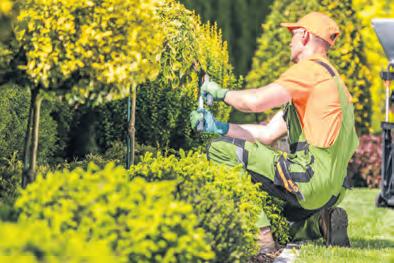
I have just finished reading Gertrude Jekyll’s book Colour in the Flower Garden and would recommend it to any gardener experienced or novice who is looking to bring something different into their garden. She really was a remarkable lady who designed and created 400 gardens in the UK, Europe and even the USA. An inspiration.

I love this quote of hers; ‘A garden is a grand teacher. It teaches patience and careful watchfulness. It teaches industry and thrift, above all it teaches entire trust’.
Maggie Davison Taunton
I bought some coir products last spring for the first time as I was looking for something different. They aren’t cheap but my experience is that they are a good new style compost and easy to use. I bought the bricks which you dissolve in water and the results in my greenhouse were a real insight. It’s nice to come across something new at my age (81 years!).
Arthur Winscombe Poole
ACCOMMODATION

NEAR WESTON-SUPER-MARE HOLIDAY BUNGALOW SLEEPS 2 £200 - £250 PW. NO PETS. PHONE FOR BROCHURE 01934 820351
Secluded cosy cabins & lodges in wooded valley running down to Wembury Bay & SW Coastal Path

Plymouth, Dartmoor & lovely South Devon Villages & Towns in easy reach. Pets Welcome. Forest School. Tel: 01752 862382 www.churchwoodvalley.com

Carmarthen Bay South Wales Seafront chalet situated on estuary. Sleeps up to 6. Seaview. Well Behaved Dogs Welcome Free of Charge. Free WIFI. Open from 1st March - 31st Dec. For Brochure Tel: 01269 862191
BOSWORLAS, ST JUST. Cosy Cottage sleeps 2-4. Please email info@bosworlas.co.uk for availability
GLORIOUS NORTH DEVON. Only 9 cosy caravans on peaceful farm. Wonderful walks in woods & meadows. Easy reach sea, moors & lovely days out. £125-395pw. Discount couples. Nice pets welcome. 01769 540366 www.snapdown.co.uk
SOUTH DEVON LODGE ON FARM. Sleeps 4. Central for beaches, Salcombe and Dartmouth. www.marymillsfarm.co.uk For availability Tel 01548 853669
ACCOMMODATION HOLIDAY COTTAGES

DEVON. TRADITIONAL COTTAGE
SLEEPS 2-4, on small farm with private woodland walks for you & your dog to enjoy. RHS Rosemoor approximately 13 miles. Tel: 01769520266 Email: horrymill@aol.com www.horrymill.co.uk
WYE VALLEY/FOREST OF DEAN. Fully equipped single-storey cottage with two en-suite bedrooms. Wi-fi.Recently awarded Visit England 4-star GOLD. Rural retreat, shops/pubs one mile. Enquiries welcome. AS SEEN ON ESCAPE TO THE COUNTRY!
Tel: 01594 833259 www.cowshedcottage.co.uk
RYDE COTTAGES, ISLE OF WIGHT. Sleep 2 and 4. Close to beach and town. 02380849565. rydecottage@talktalk.net. www.rydecottage.co.uk
ACCOMMODATION WITH BEAUTIFUL GARDENS


Gloucestershire Quality Bungalow B&B
Ensuites, rural, large garden, paddocks, sheep and fruit. Ideal Cotswolds, Malvern’s, Forest of Dean, cycle storage, ample parking, Wi-Fi £44 p.p.p.n. Tel: 01452 840224 sheila.barnfield1960@gmail.com

A range of over 200 greetings cards and prints from the flower paintings of ANNE COTTERILL
We sell to both individuals and trade. No order too small. Contact us for your free catalogue.
Mill House Fine Art Publishing, Bellflower Gallery, Market Place, Colyton, Devon EX24 6JS Tel. 01297 553100 info@millhousefineart.com www.millhousefineart.com

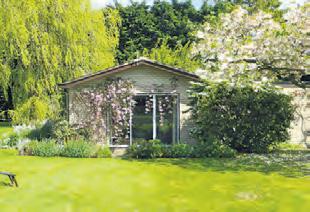
Near Stratford-upon-Avon

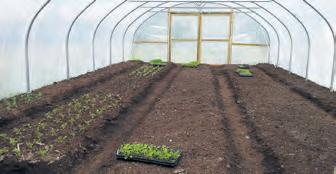






Artist blacksmith based near Axminster designing and manufacturing garden plant supports, structures, garden art and fine art bronzes. Commissions welcomed. www.thegardenersblacksmith.co.uk

Lovely self-catering cottage in peaceful location: large garden. Sleeps 2. Perfect for famous gardens, NT properties & Cotswolds. Tel: 01789 740360 www.romanacres.com THE GARDENER’S BLACKSMITH jonne@jonne.co.uk 07770 720 373
NORTH DEVON NEAR CLOVELLY. 3 delightful cottages situated in 12 acres of idyllic countryside. Sleeps 2-4. 1 Wheelchair friendly. Brochure: 01237 431324 www.foxwoodlodge.co.uk foxwoodlodge@outlook.com


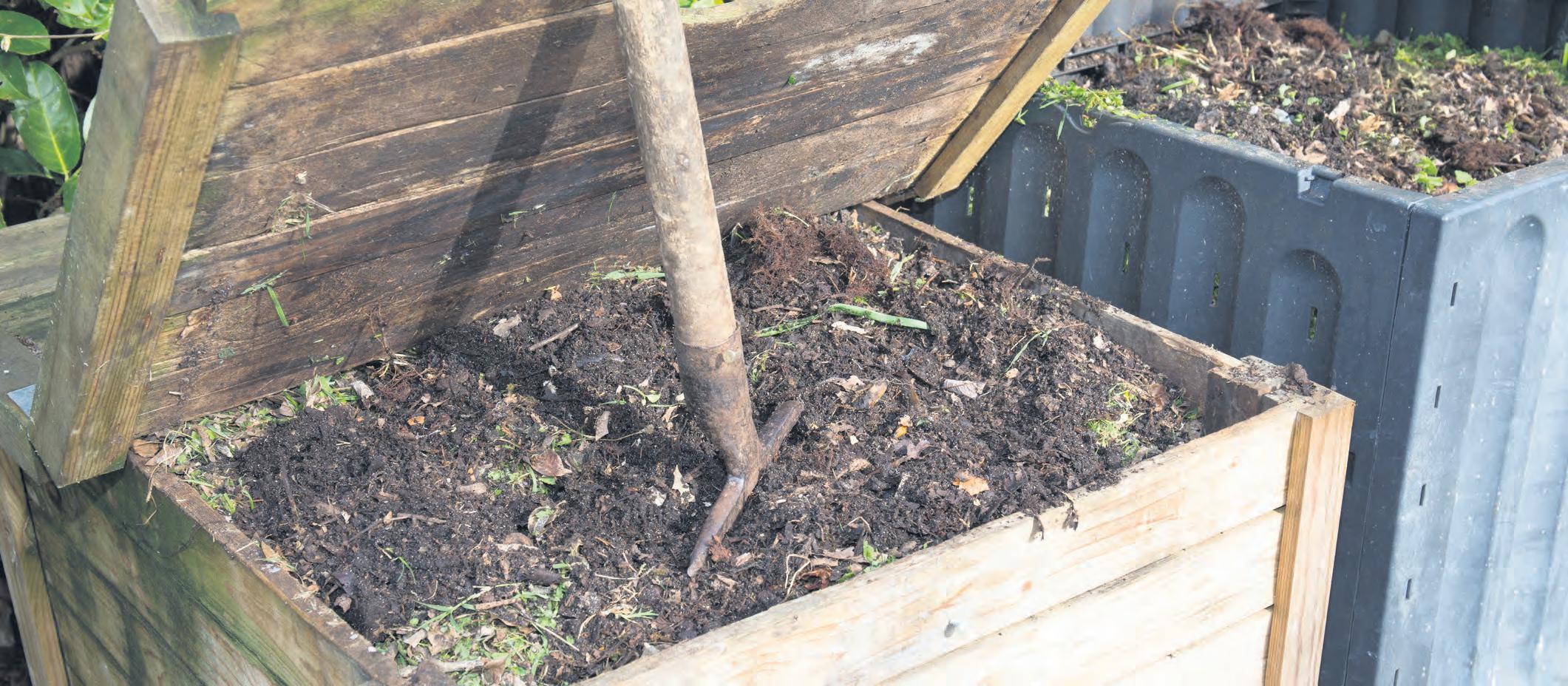
RECORD NUMBERS OF GARDENERS ARE NOW CREATING THEIR OWN GARDEN HOME MADE COMPOST BUT THERE ARE STILL SOME TRICKS OF THE TRADE TO BE LEARNT
If the latest research is anything to go by, record number of gardeners have since lockdown invested in and enjoyed the horticultural art of composting.
It seems also lots more are dabbling in what is a hugely practical benefit for the garden. Composting is the natural process of recycling organic matter, such as leaves and food scraps, into a valuable fertilizer that can enrich soil and plants. Anything that grows decomposes eventually; composting simply speeds up the process by providing an ideal environment for bacteria, fungi, and other decomposing organisms (such as worms, sowbugs, and nematodes) to do their work. The resulting decomposed matter, which often ends up looking like fertile garden soil, is called compost. Fondly referred to as ‘black gold,’ compost is rich in nutrients and can be used in almost every aspect of gardening.
Q: WHAT MATERIALS CAN I COMPOST?
Grass cuttings
Weeds
Glossy or coated paper and printed materials
Synthetic fibres and bioplastics
Leaves Chewing gum
Hedge clippings
Uncooked food (tea bags, vegetable peelings, apple cores, banana skins, egg shells, etc)
Shredded paper and card
Cooked foods
Cat and dog litter
Diseased plants
Meat and fish
Persistent weeds
Some compostable plastics
Invasive weeds
Produce stickers
Hygiene products
Q: CAN I PUT JUST ONE MATERIAL IN MY COMPOST BIN OR DOES IT NEED A MIXTURE?
A: To make good compost add a variety of compostable materials and create loose layers. Avoid heavy layers of grass cuttings or leaves.
Q: SHOULD MY COMPOST BIN BE DRY OR WET?
A: Keep your materials damp but not wet. Add small quantities of water, or moist grass clippings and leafy materials, if the compost is drying out. Or add drier material such as shredded newspaper if the mixture is too wet.
Q: MY COMPOSTER GIVES OFF A NASTY SMELL. WHY IS THIS AND WHAT CAN I DO ABOUT IT?
A: This is because your compost is too wet and is breaking down anaerobically, meaning without oxygen. To help reduce the wetness, try leaving the lid off in dry weather, removing some grass clippings, or adding some shredded paper. Turn regularly with a garden fork to mix dry and wet materials to improve air circulation.
Q: HOW LONG DOES IT TAKE TO MAKE COMPOST?
A: Composting can take weeks or months, depending on how much air and moisture the material receives. By turning the compost regularly to help add air you should make compost in three to six months.
Q: WHAT CAN I ADD TO SPEED UP THE PROCESS?
A: Compost can take a while to make. A slow turn over may be because the material isn’t reaching high enough temperatures. Try moving the composter into sunlight and keep the lid on. It could also be that it’s too dry, so keep the pile moist. Try adding an activator; ready-made activators can be bought from garden centres. Young nettles help to speed the process up too.
Q: WHY DOES COMPOST TURN WET AND SLIMY?
A: Usually because you have put in too much soft material, grass clippings, and vegetable peelings. Make sure you get a good mixture of materials and add choppedup dry twigs, wood chips, and some shredded newspaper to give the compost a better texture.
Q: CAN I COMPOST MY HEDGE CLIPPINGS?
A: You can compost green waste. This includes fallen leaves and prunings from hedges. Ensure you get a good mixture of materials in your compost pile as well as the hedge clippings. Any woody stems and branches will take longer to decompose and you may want to take those to your HouseholdWaste Recycling Centre (HWRC) or add them to your collections for larger-scale composting.
Q: WILL HAVING A COMPOST HEAP ATTRACT RATS?
A: Compost heaps may highlight the fact that vermin are in your local area. Remove any unsuitable materials and remember what can and can’t be composted. Try placing chicken wire round the base of the compost heap.
Graham Matthews, food waste expert told us: “Composting your organic waste at home is a great way to help reduce the amount we throw in landfill sites every year. Alongside this, creating your own compost is a fantastic option to help your garden grow and save money.
“By digging compost into the soil it improves soil texture and nutritional quality. Using compost as mulch around plants can help to retain moisture. The organic matter in compost helps to break up heavy clay soils, making them lighter and much easier to work. Alongside this, creating and using your own compost means you’ll buy less peat and fertilisers, in turn saving money.”
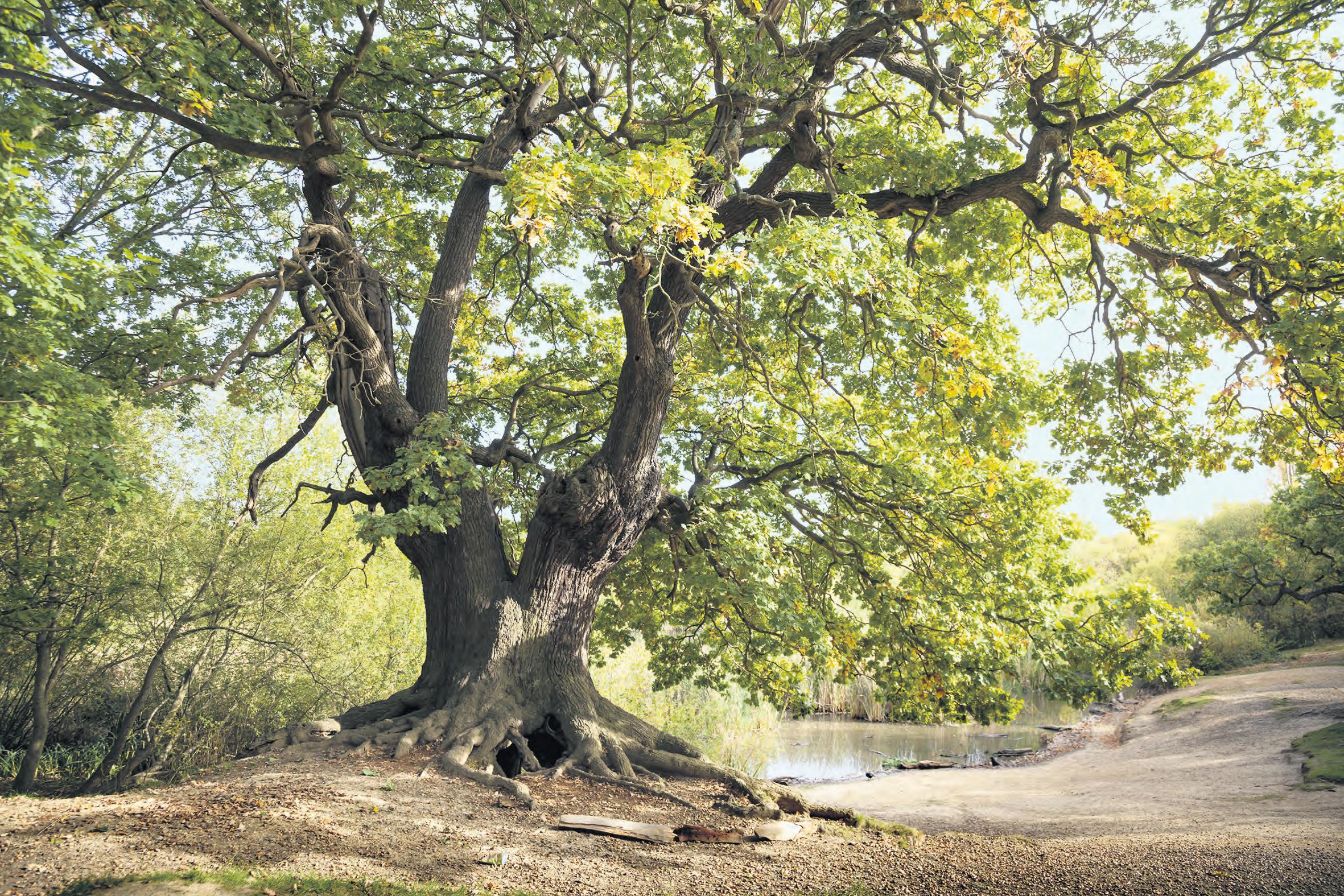
I saw a programme on the television regarding a campaign by the Woodland Trust to record all our ancient trees and lobby for them to receive listed building status.
The programme particularly mentioned some ancient yews.
I waited for some mention of Tim Hills and the Ancient Yew Group, who have been recording the location and dimensions of Ancient Yews in this country for more than 20 years (look up their website, they are all there).
Oh well, I was sure that Ted Green and Jill Butler of the Ancient Tree Forum would be given a mention. After all, it was their idea years ago to start lobbying the Government for ancient trees to be given the same status as listed buildings, whilst also inspiring the formulation of the Ancient Tree Register, where people can send in the details of ancient trees in their area for inclusion on the list.
Not a dickie bird.
If one didn’t know better, one might imagine that the Woodland Trust had just thought the whole thing up and was beginning a register of ancient trees from scratch!
Now, I have occasionally been involved over many years with matters or situations which ended up being reported in some kind of media. I have to say that I have
Editorial Publisher & Editor: Alan Lewis alan@countrygardener.co.uk
Tel: 01823 431767
Time Off
Kate Lewis timeoff@countrygardener.co.uk
never seen a 100 per-cent accurate report on anything. The only publication you can fully trust is the Country Gardener magazine.
For this reason, I am not suggesting that the Woodland Trust would be stupid enough to ignore highly intelligent, learned people who have dedicated a significant chunk of their lives to the protection of ancient trees. It was just bizarre that the documentary seemed to suggest it.
The proposition, that ancient trees are given similar status to listed buildings, is important. However, it will have to be carefully managed. Ancient trees have already been given enhanced status in the planning system, and I have seen council officers trying to give ordinary ‘old’ trees ‘ancient’ status to increase their negative influence on a planning application.
If they continue to try that they will discredit the whole process.
I am sure you are all aware of Tree Preservation Orders (TPOs) and Conservation Areas which offer trees protection. A status like listed buildings would change a couple of things significantly. Firstly, trees which are dead or dangerous are exempted from TPOs and ‘dangerous’ can be a very elastic word. Hollow, gnarly old ancient trees are often at risk of being felled by health and safety fanatics – particularly if it suits their
Advertising Sales
Ava Bench - Somerset, Classifieds & Speakers Guide
ava@countrygardener.co.uk
Tel: 01278 786139
Corina Reay - Cotswolds, Devon, Dorset & Hampshire corina@countrygardener.co.uk
Tel: 01823 410098
purpose. Listed status would remove that risk and probably reduce the liability of the tree owner at the same time.
Secondly, TPOs only prevent actions – if your tree has a TPO you do not have to do anything to nurture it, it is very much on its own. However, anybody with a listed building will know that you have a legal obligation to maintain it; you cannot just let it fall down.
If the same were true of ‘listed trees’ the situation would arise that, rather than felling a tree on the grounds that it is dangerous, the owner would have to take reasonable steps to make it safe whilst still retaining it. That would be a massive game changer for our precious ancient trees.
The Ancient Tree Forum runs courses for understanding and managing veteran trees. I went on the course in 2023 – it is very good.
People who did the course and took the exam after it are going to be needed, because all this stuff has to be done from knowledge not whims.
Mark Hinsley, of Mark Hinsley Arboricultural Consultants Ltd, offering tree consultancy services. www.treeadvice.info
Accounts & Payment
Heather Rose heather@countrygardener.co.uk
Distribution & Stockists distribution@countrygardener.co.uk
Design & Production
Aidan Gill aidan@countrygardener.co.uk
Gemma Stringer gemma@countrygardener.co.uk
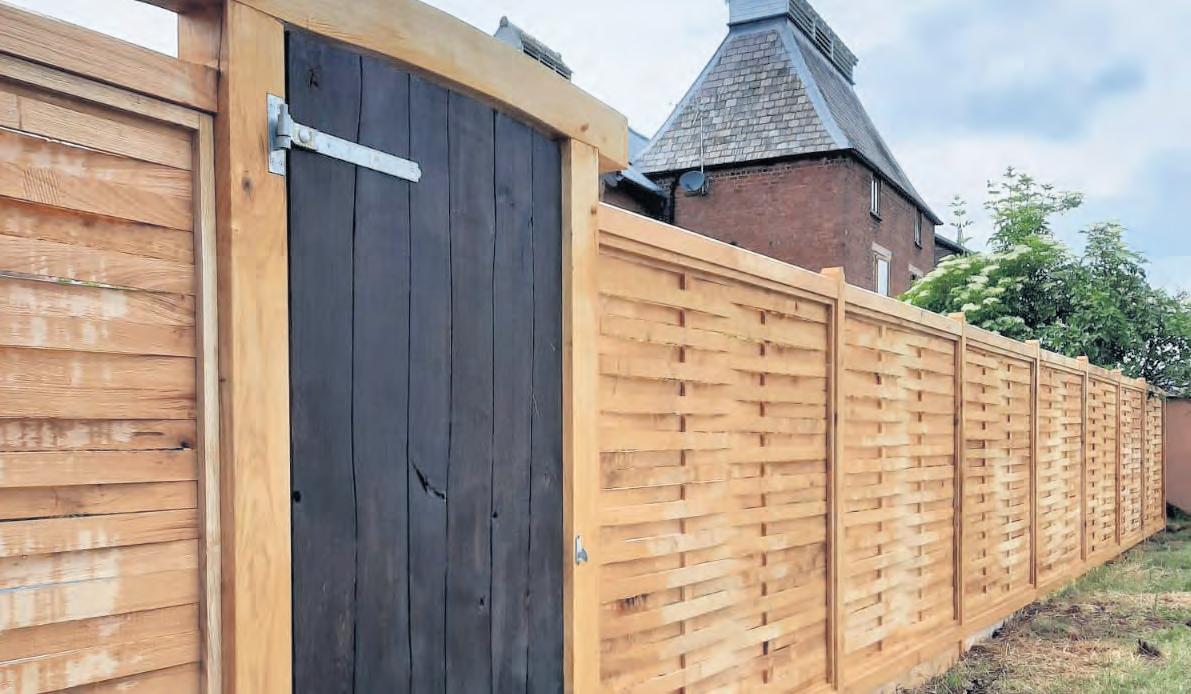







We are an independent Plant Nursery on the outskirts of Ledbury. Most of our plants are grown on site with additional stock sourced from local specialist growers.
Vegetable Plants, Fruit Trees, Seeds... and some fabulous ideas for growing Vegetables in Patio Containers
Meander around our garden displays and be inspired to plant out your own garden
Over 100 varieties of Heuchera “Collectors Corner” of Unusual and Hard to Find Plants

Hints
Booking
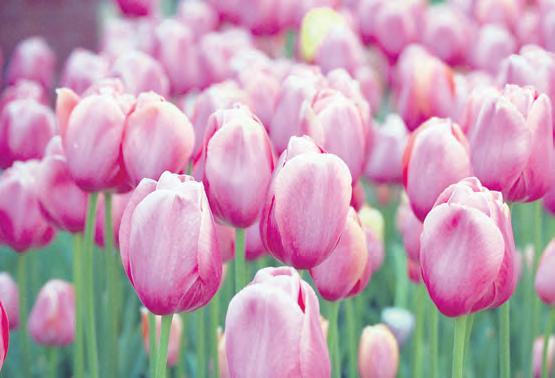


7 Days a week Newent Plant Centre @ The Nest, Little Verzons, Hereford Road, Ledbury HR8 2PZ.
TEL: 01531 670121 EMAIL: enquiry@newentplantcentre.co.uk


